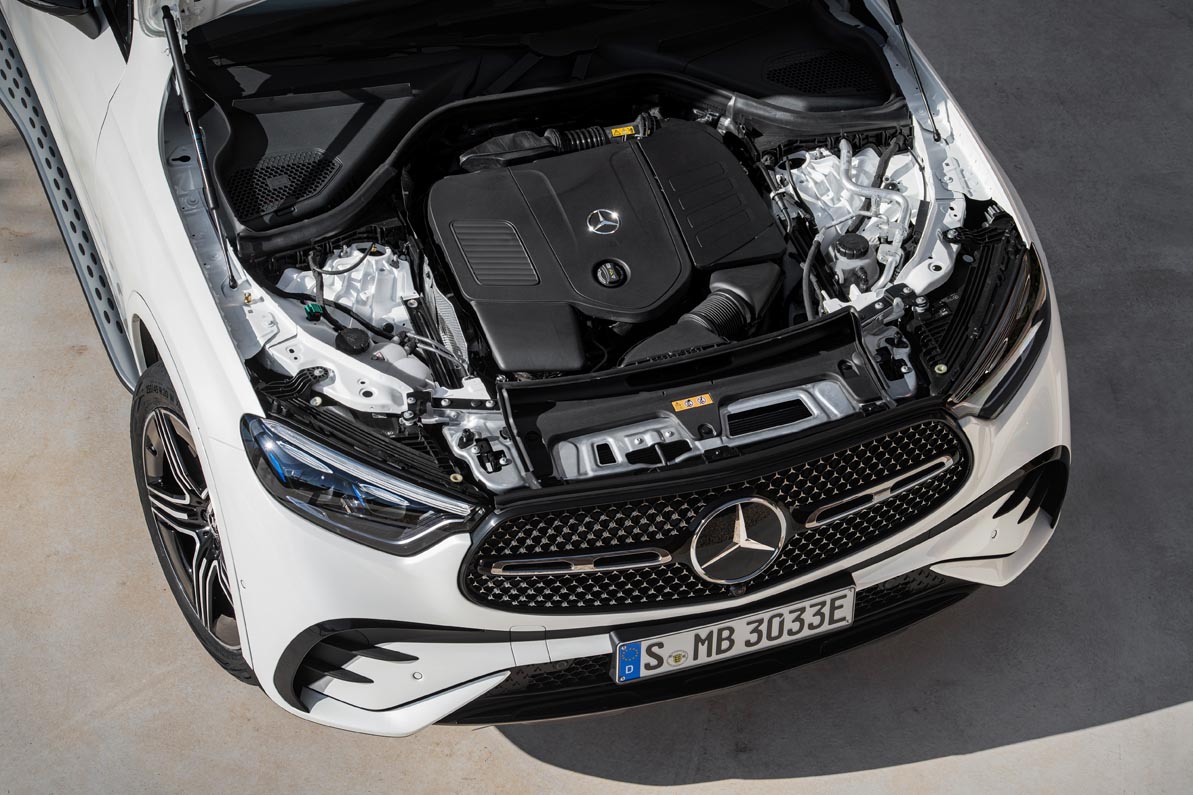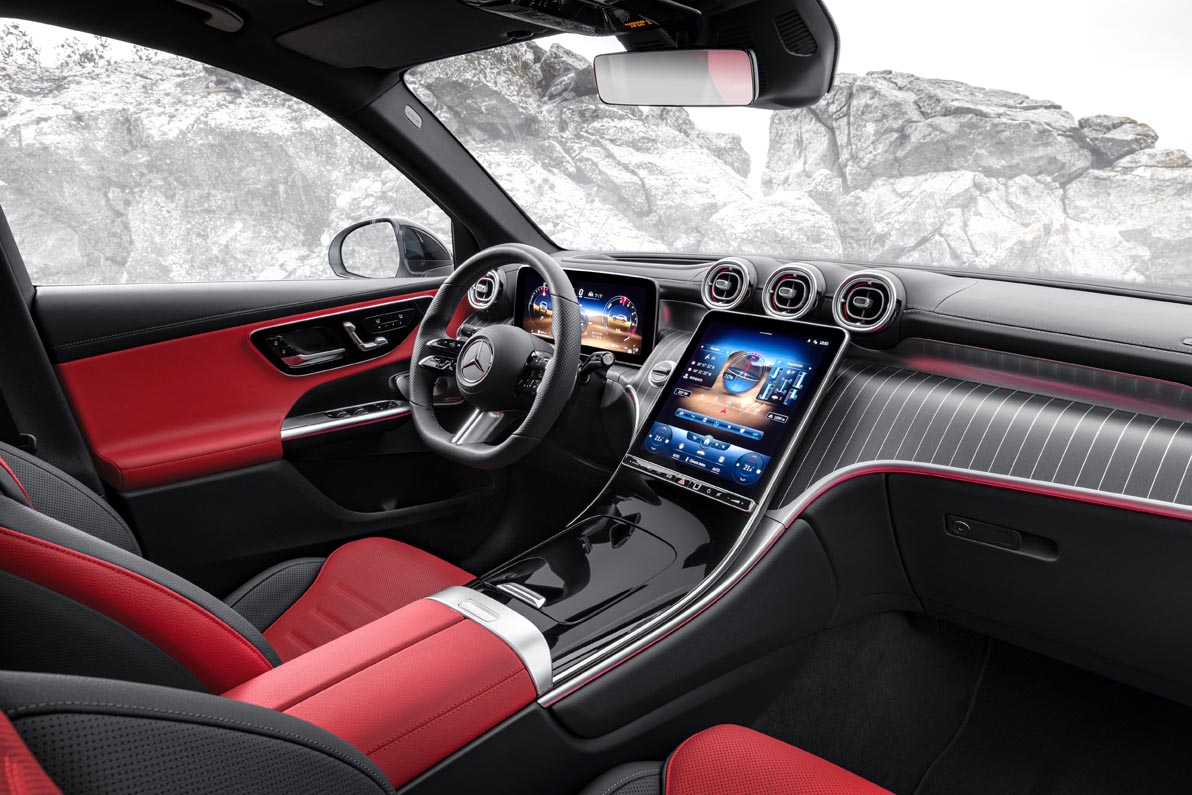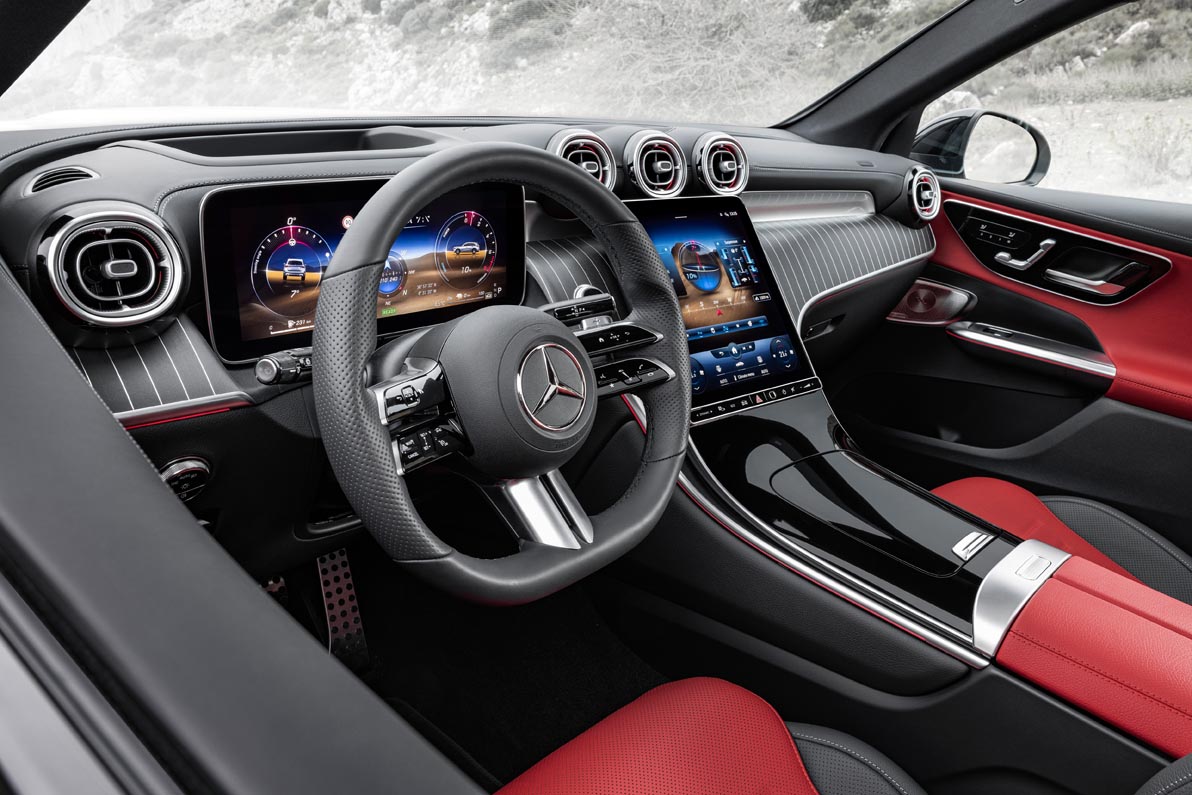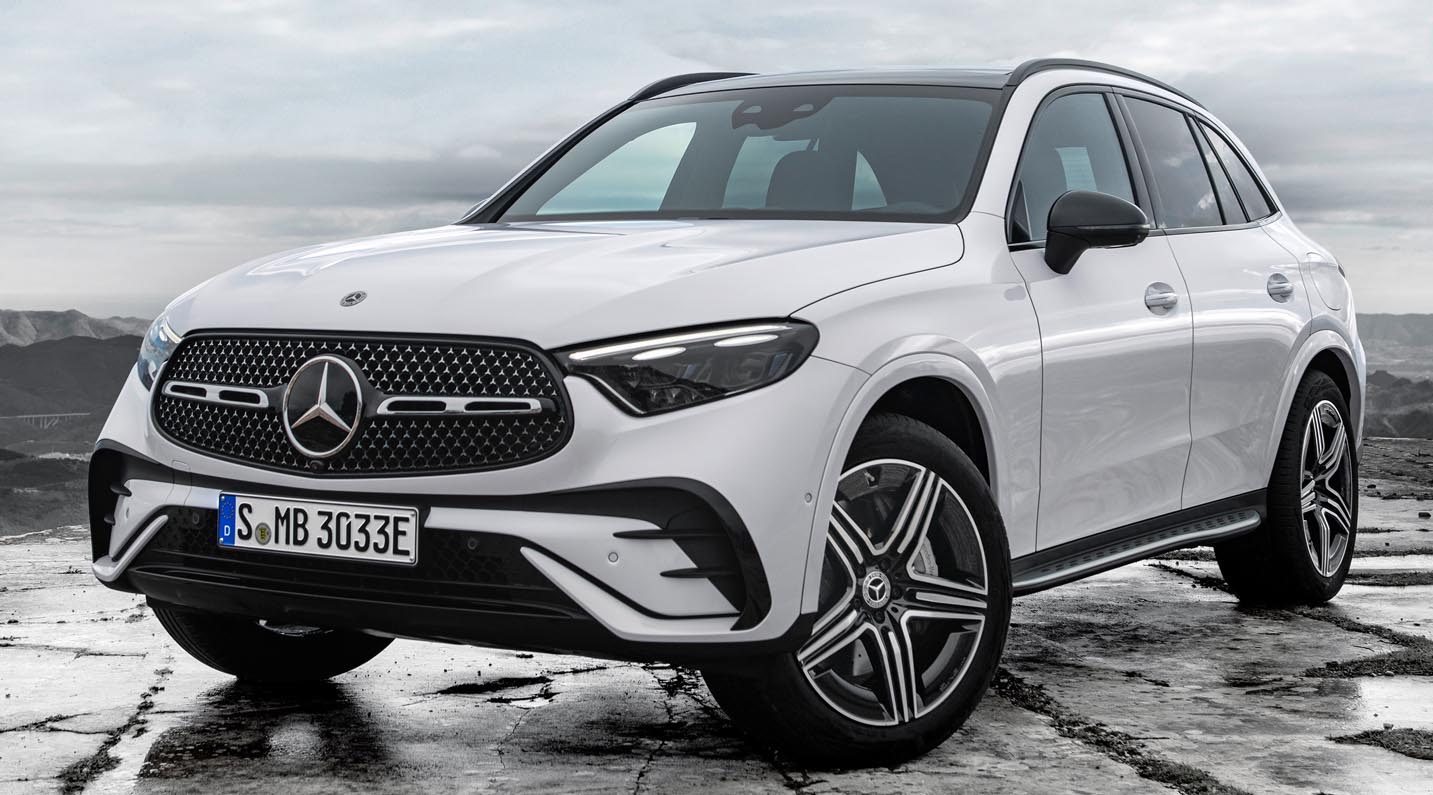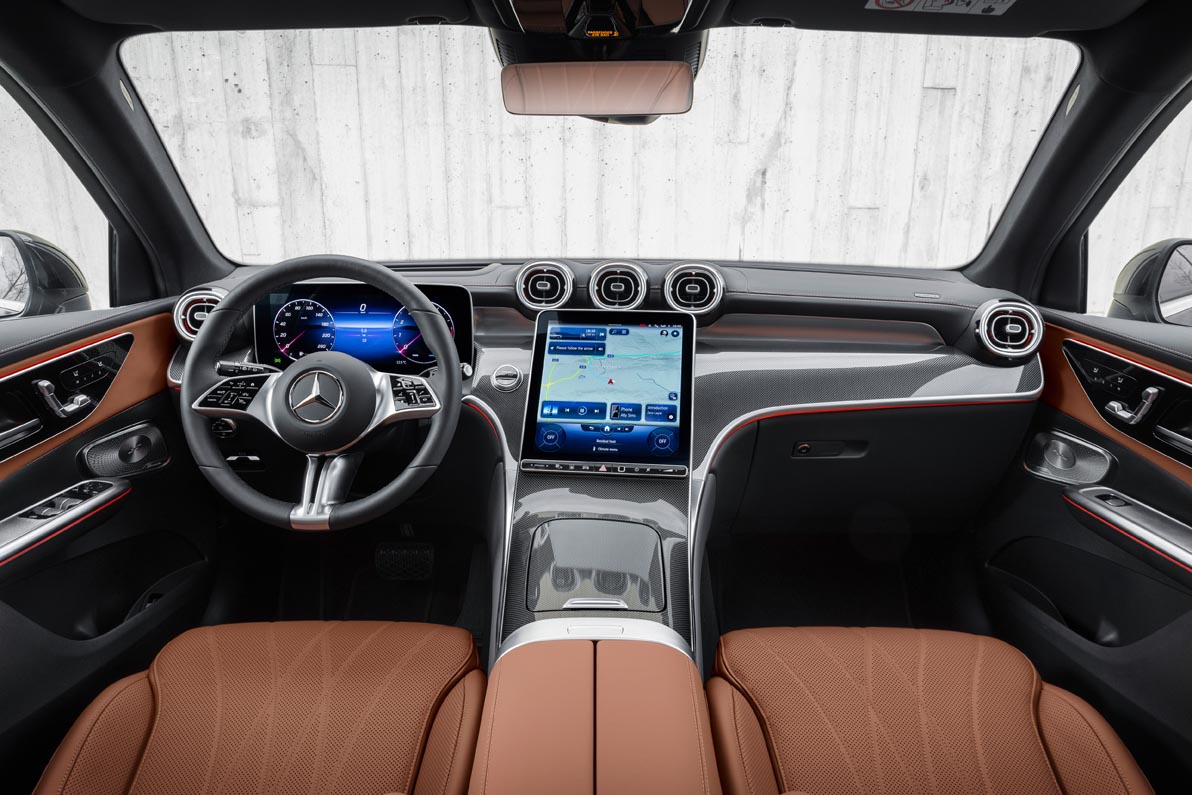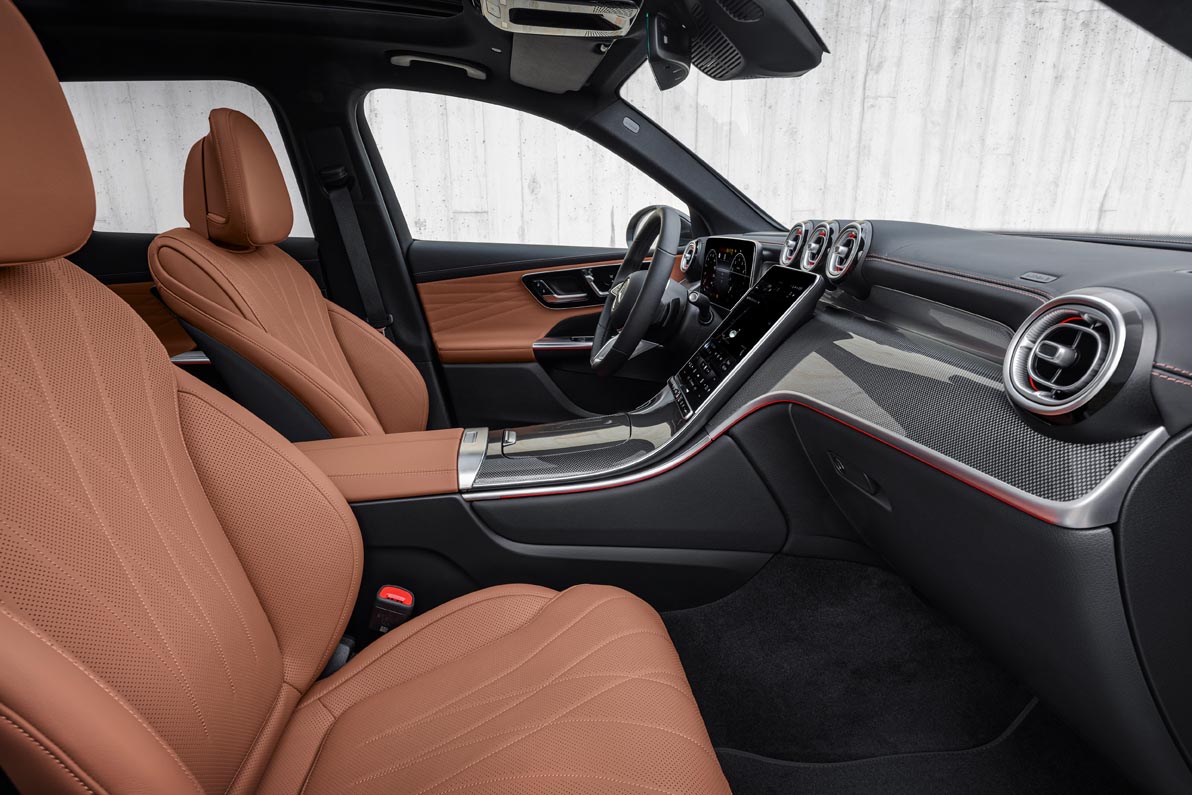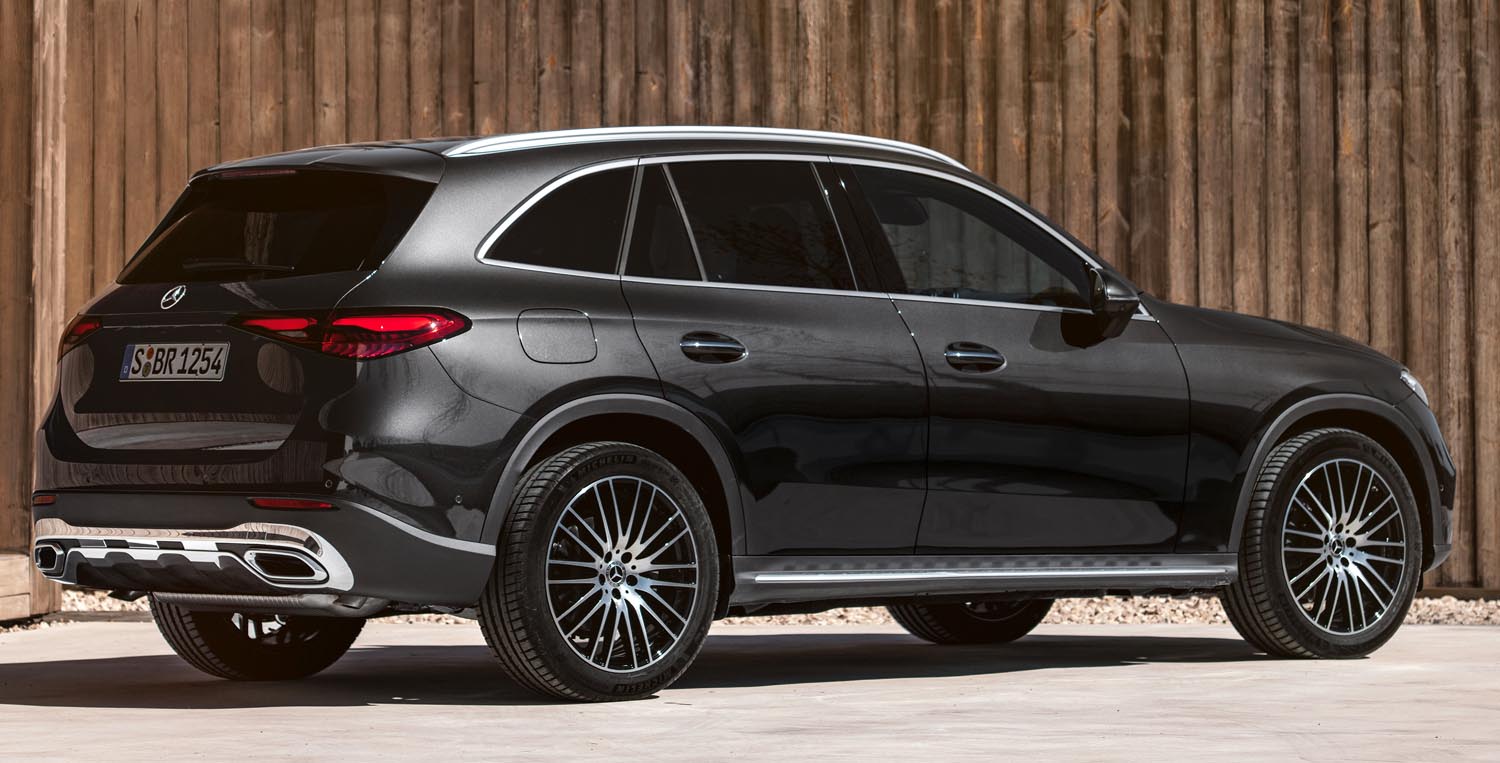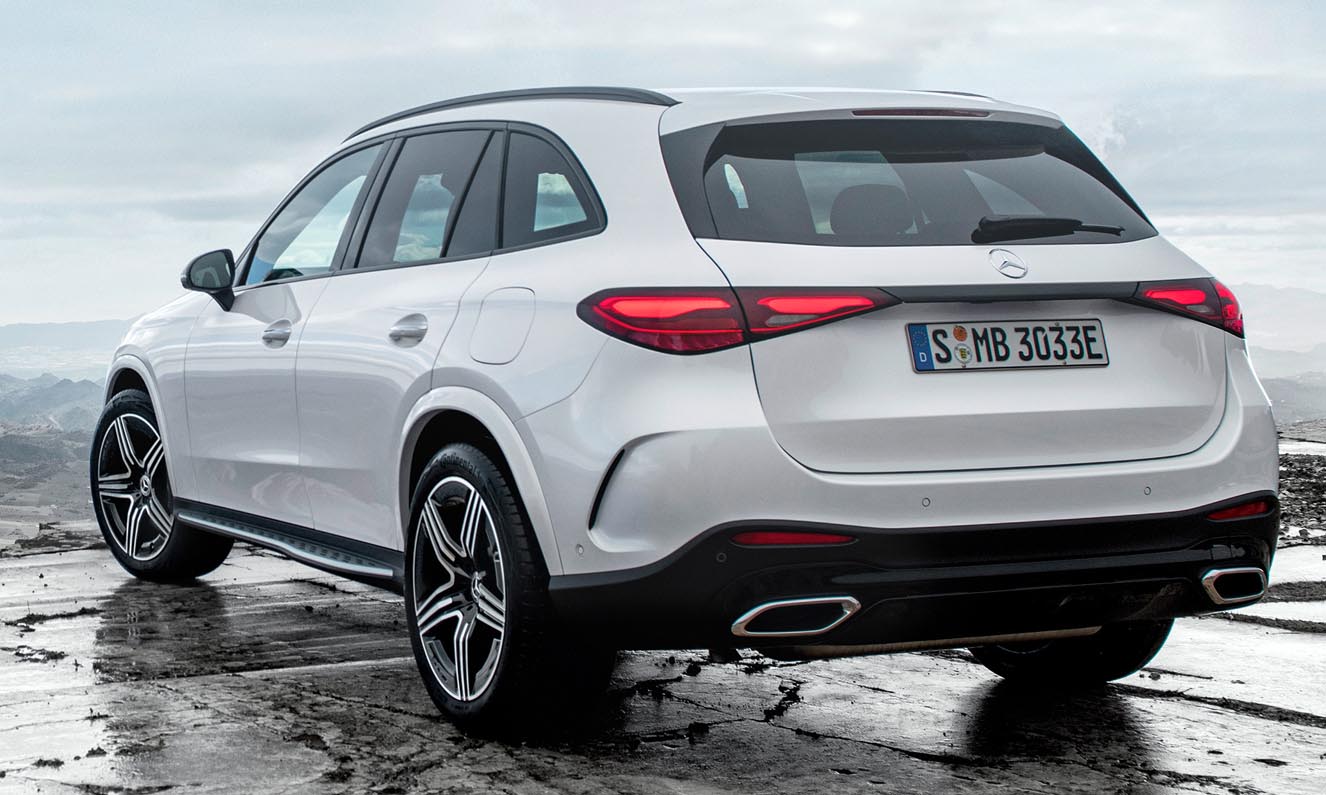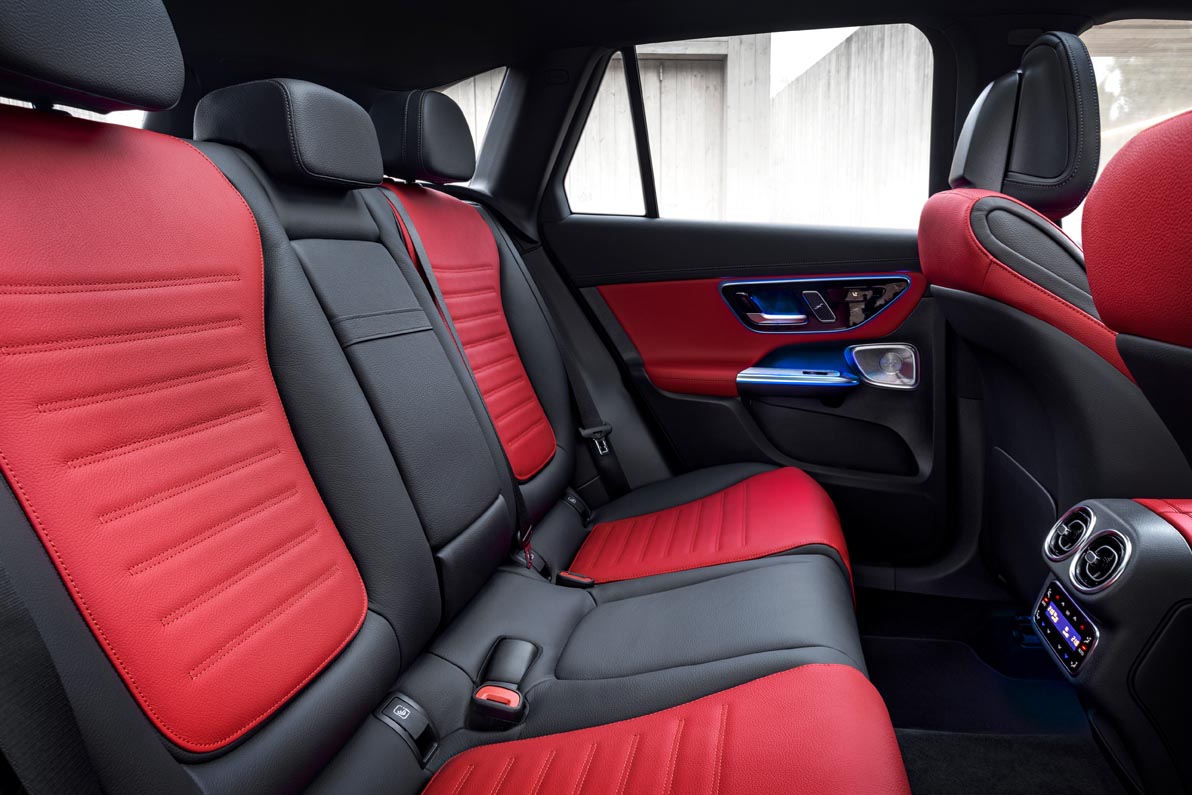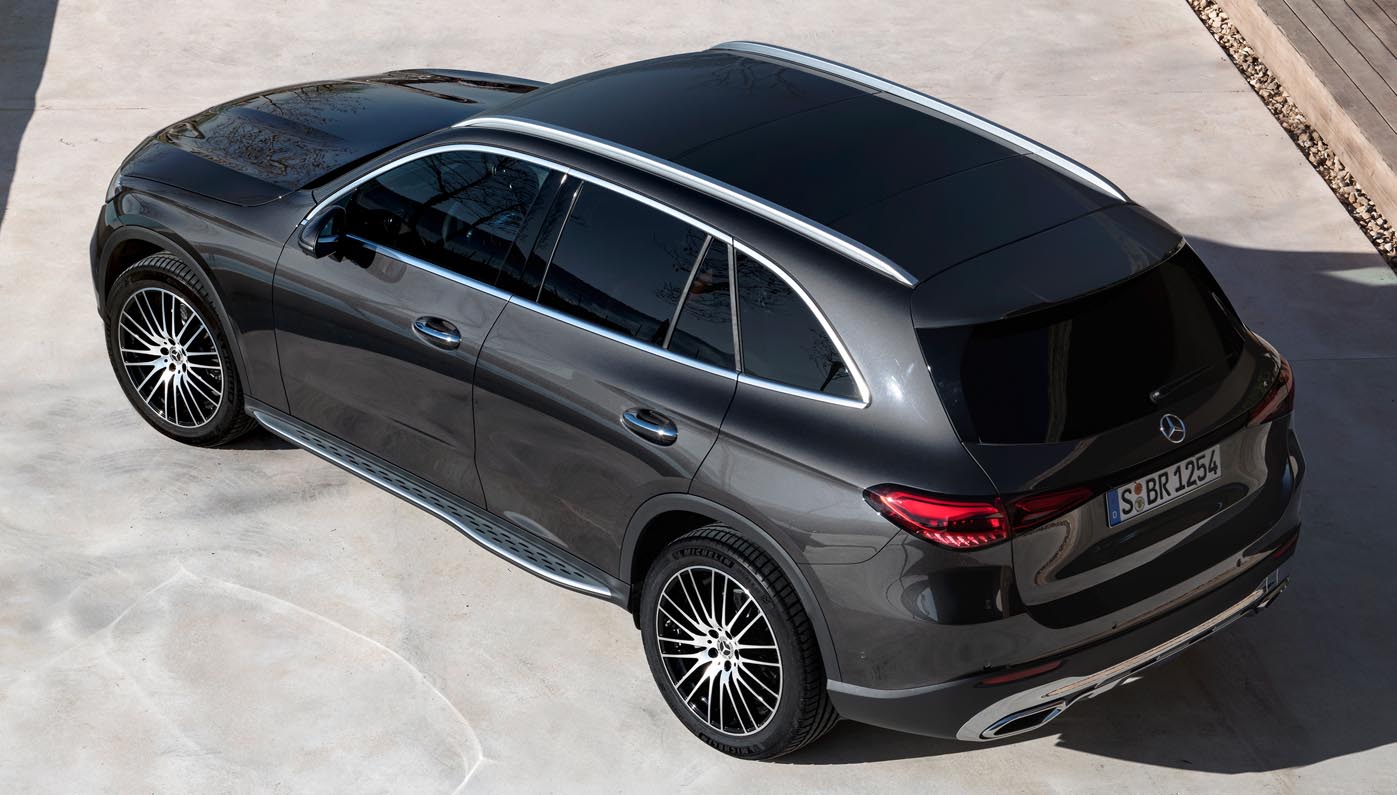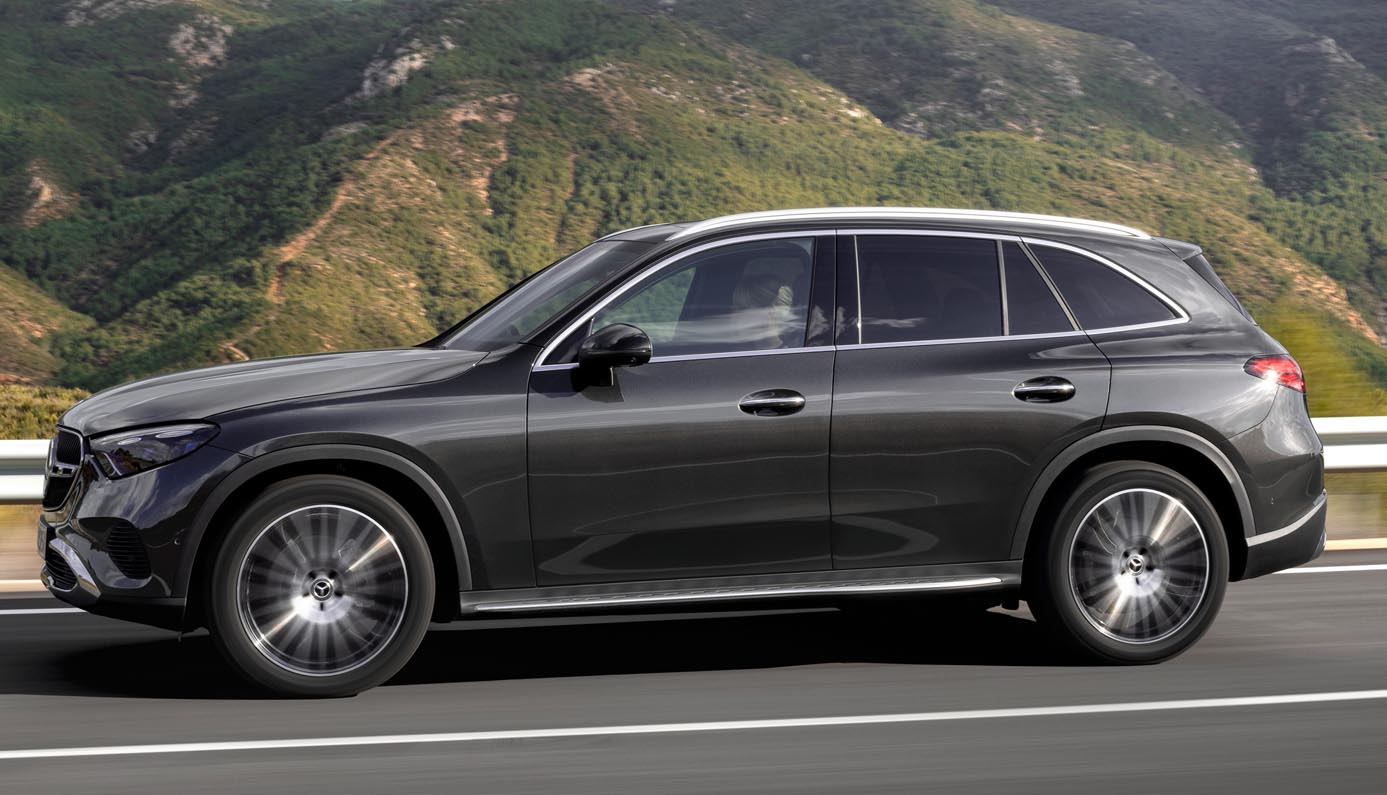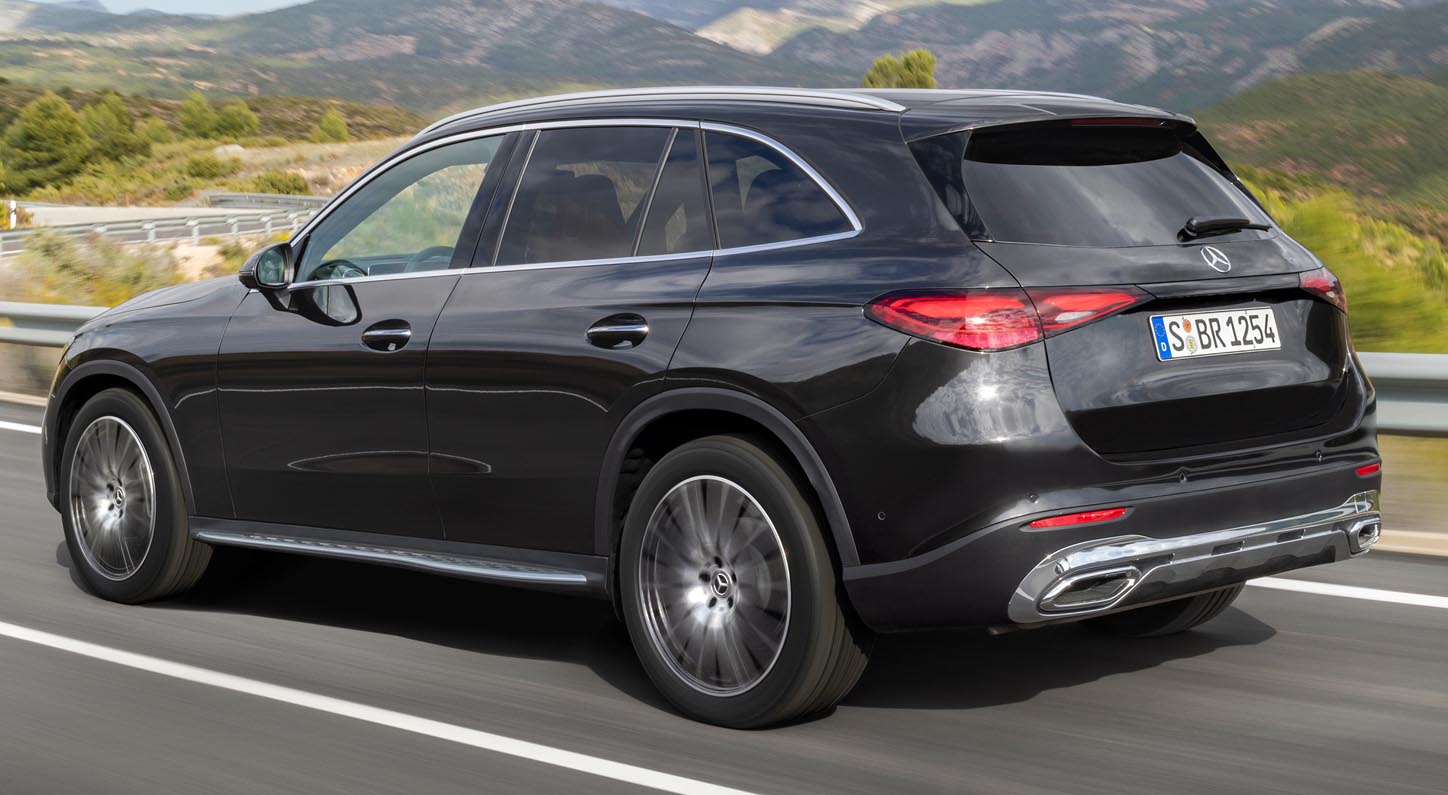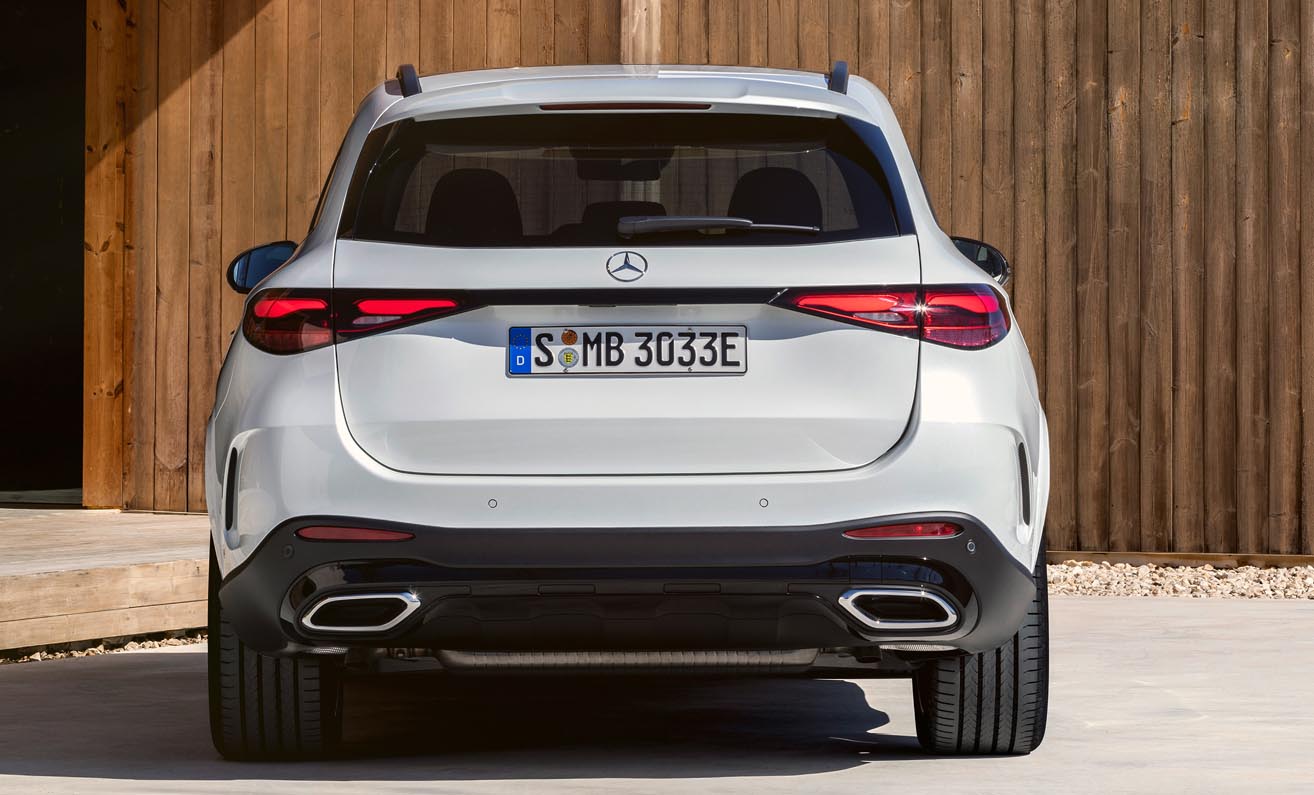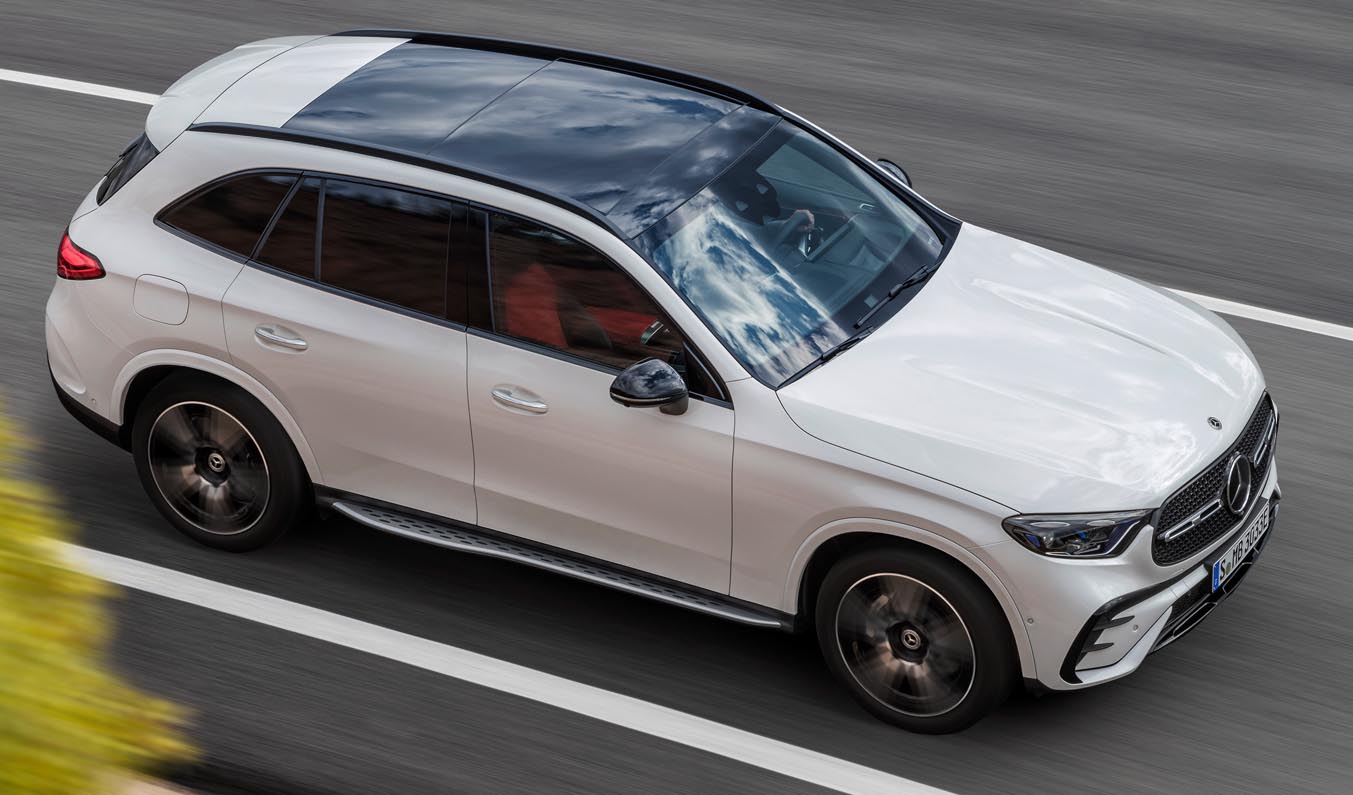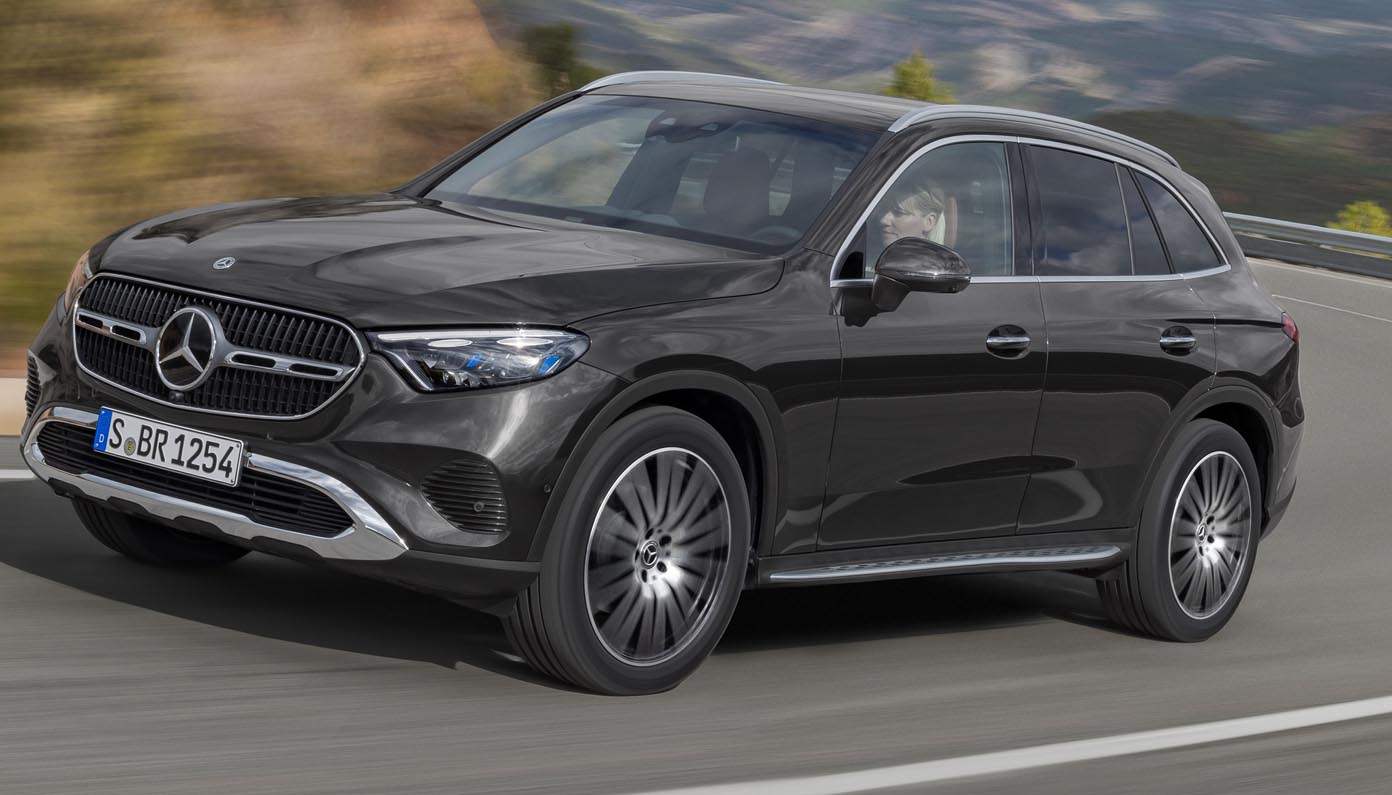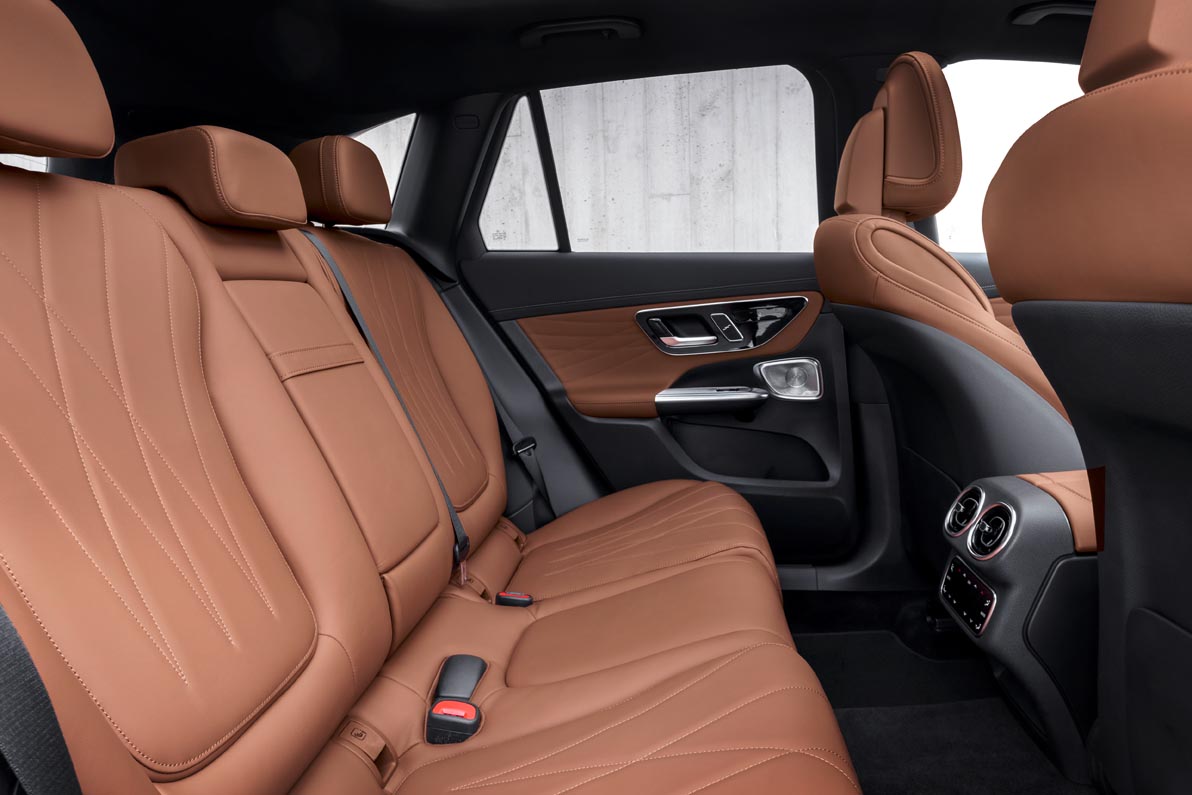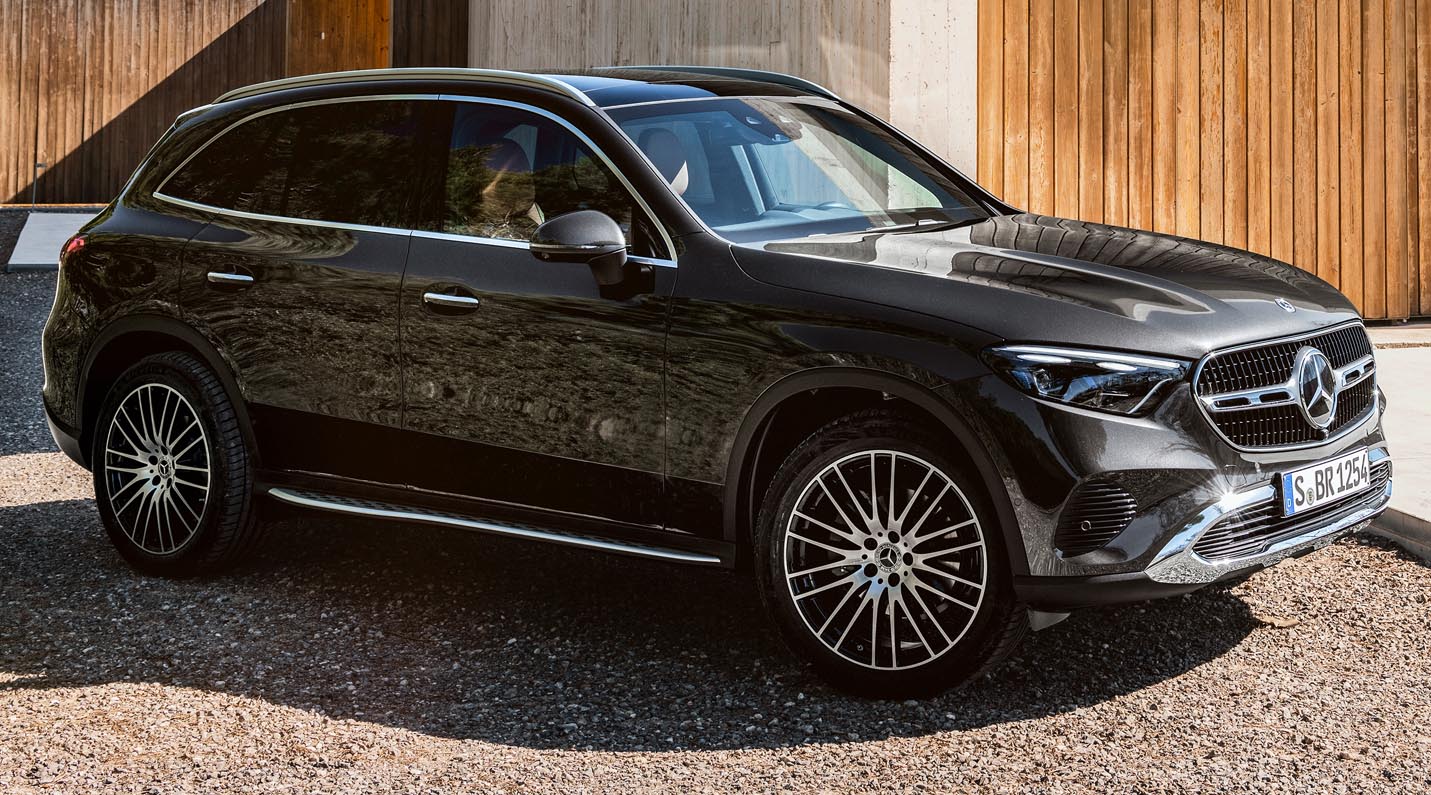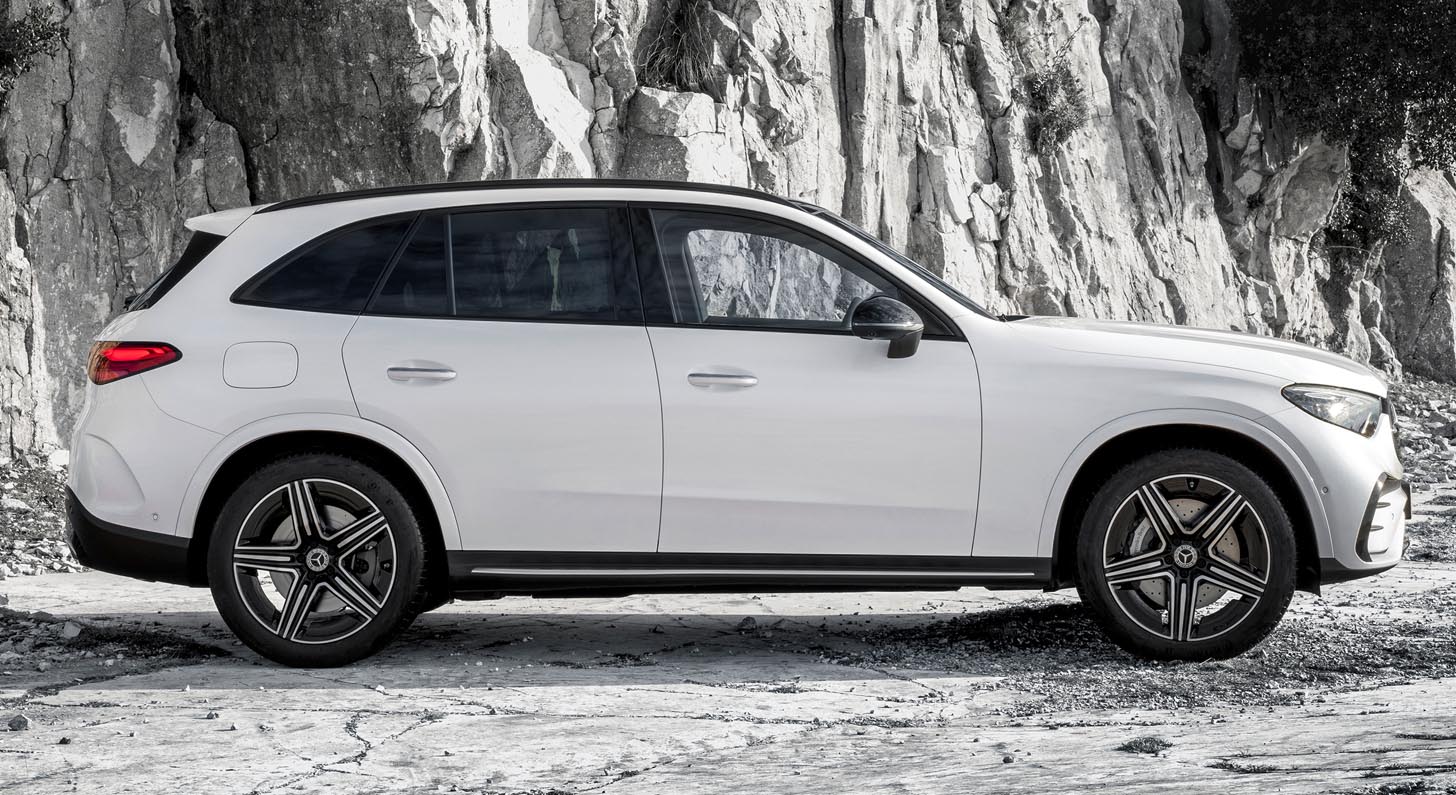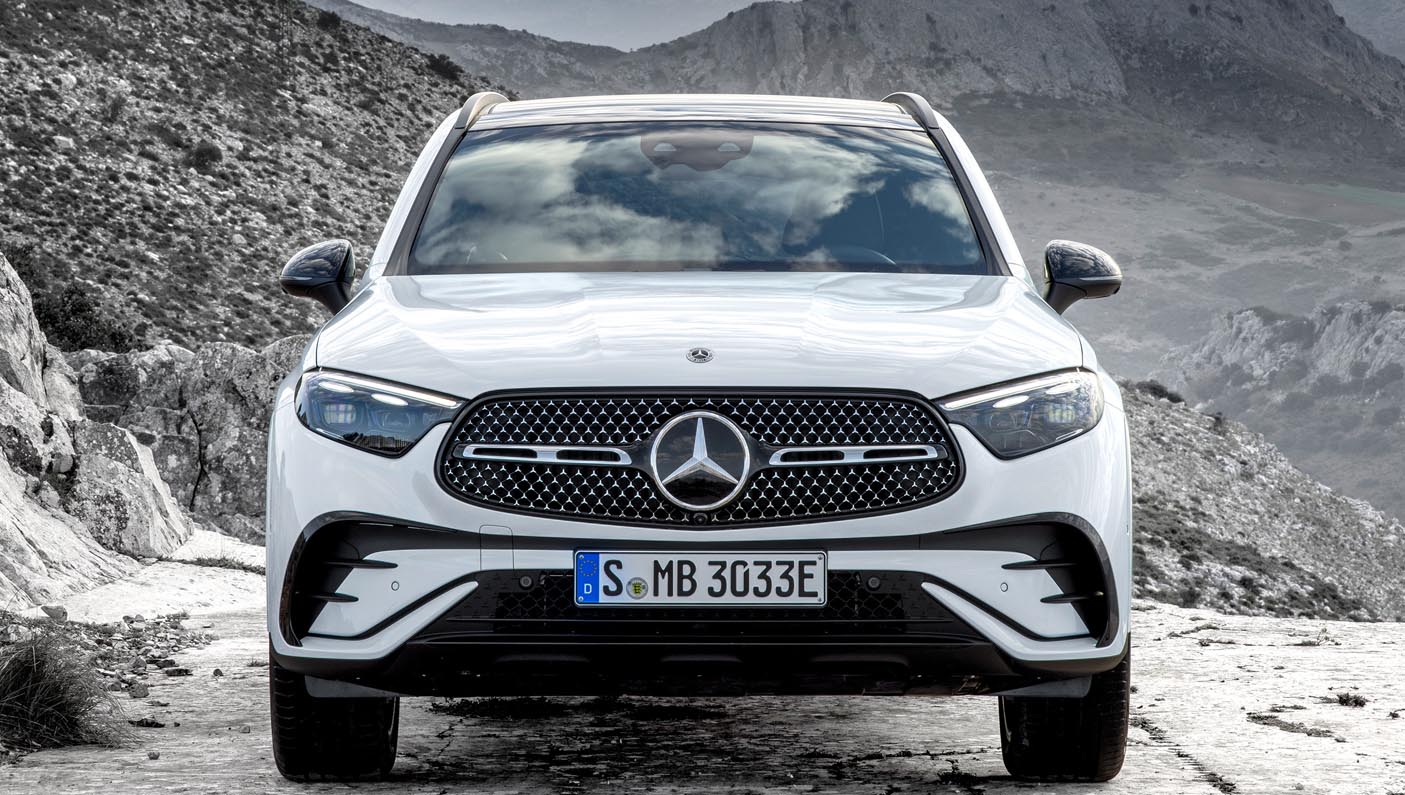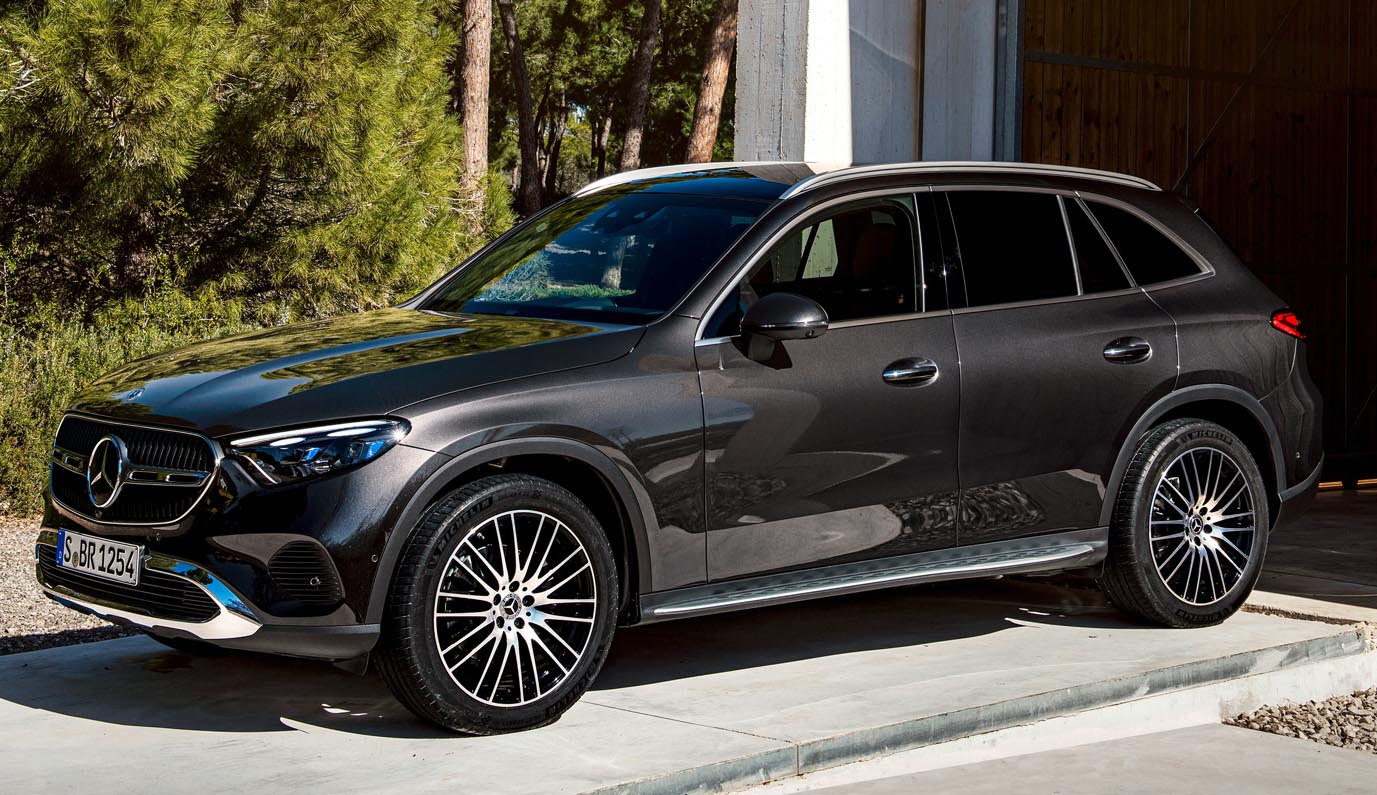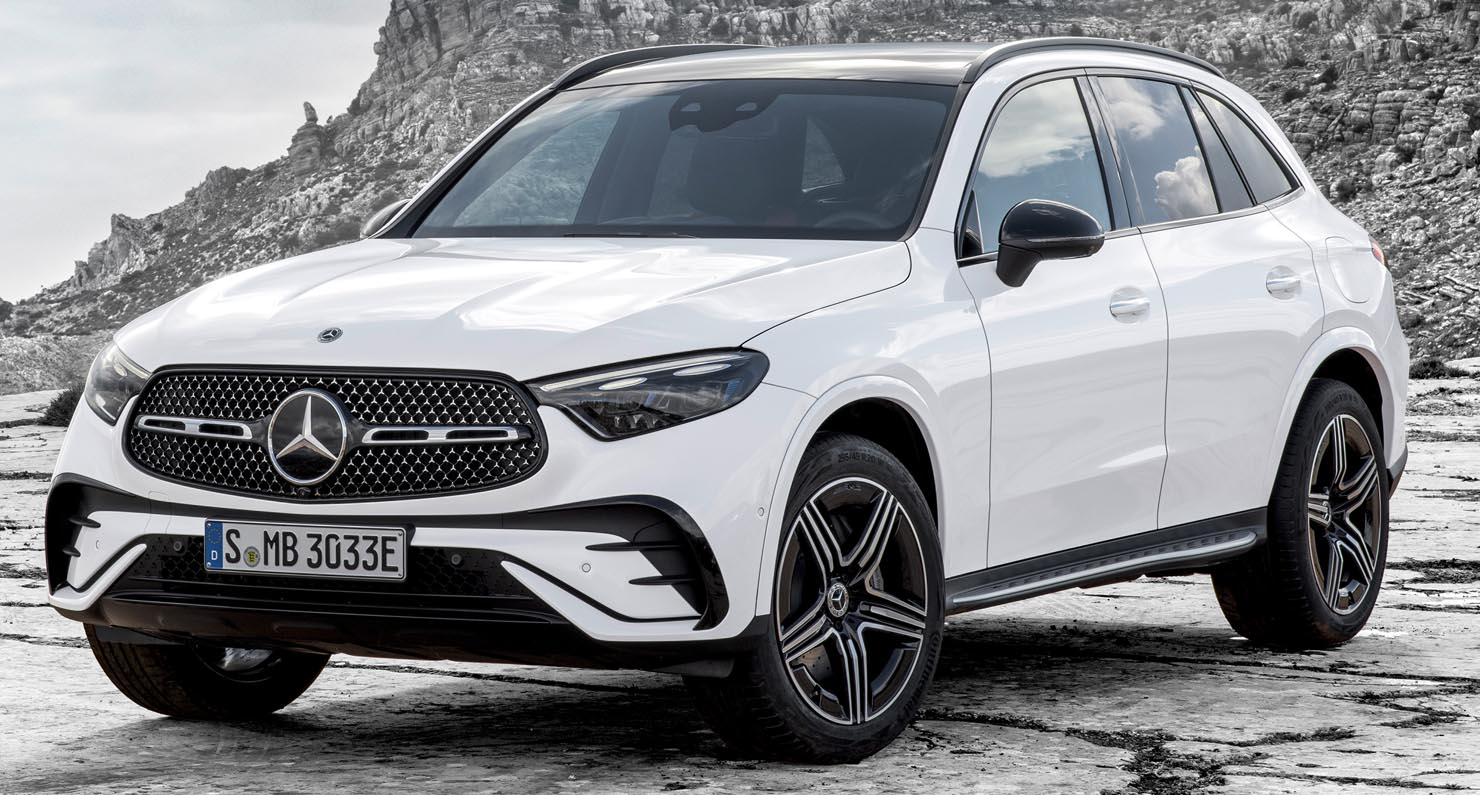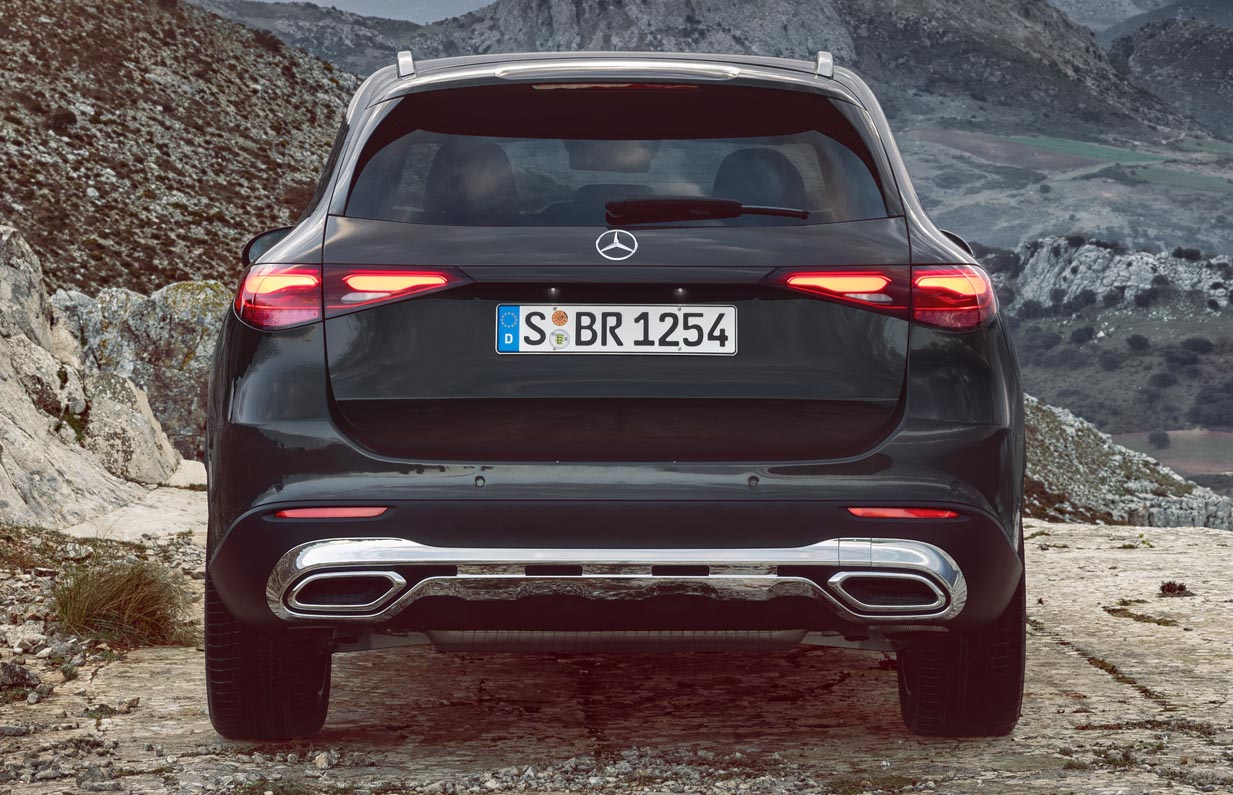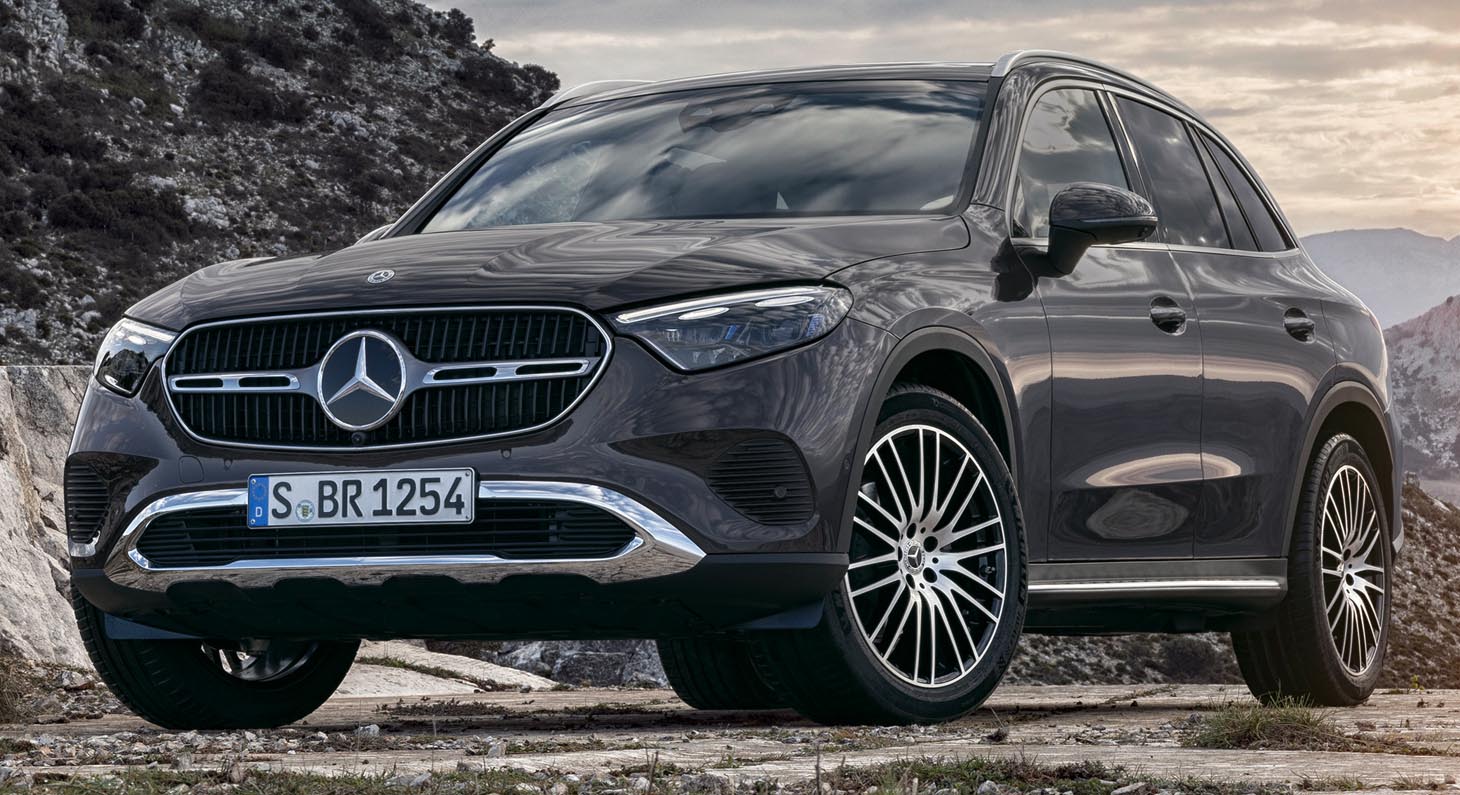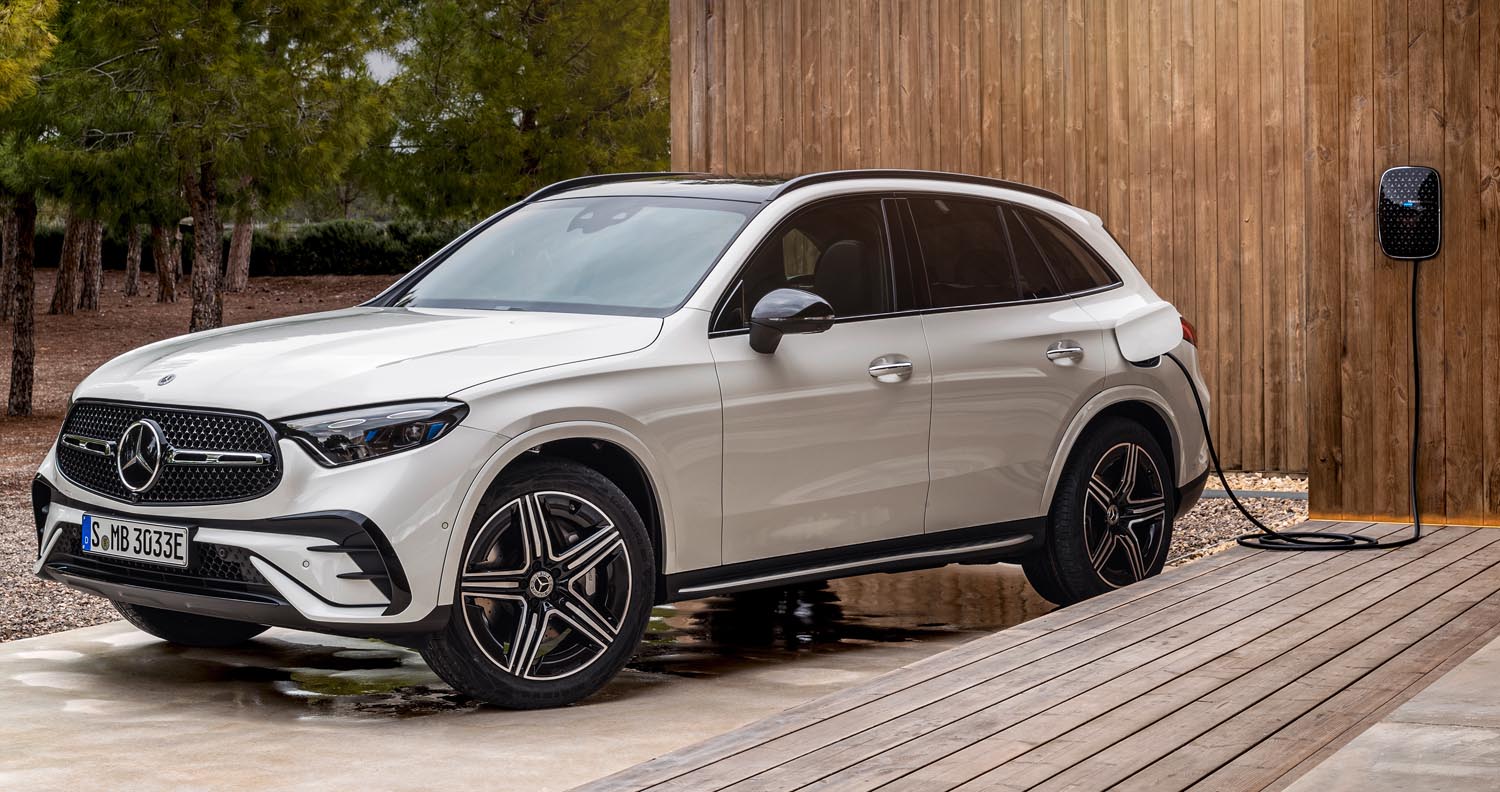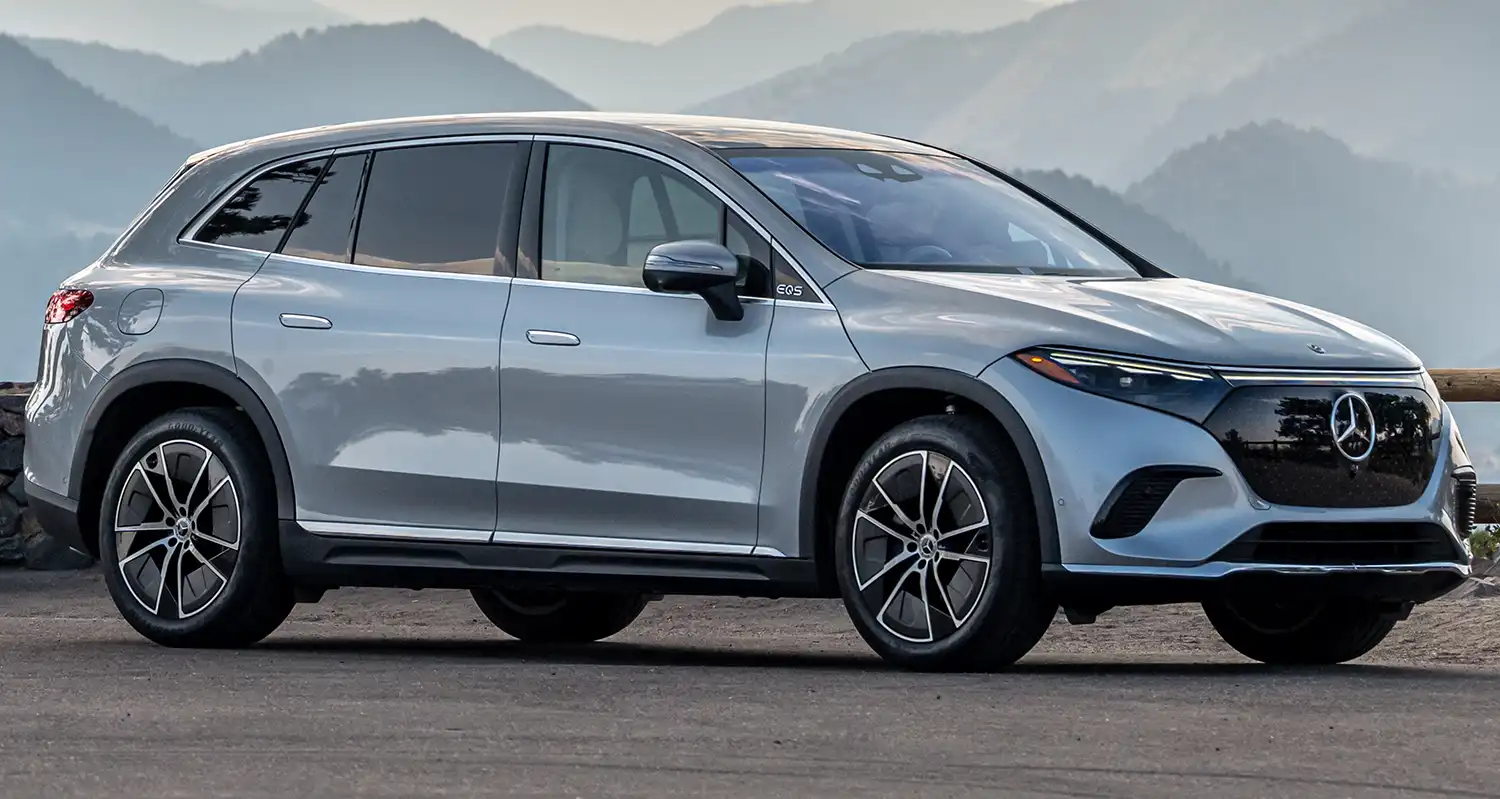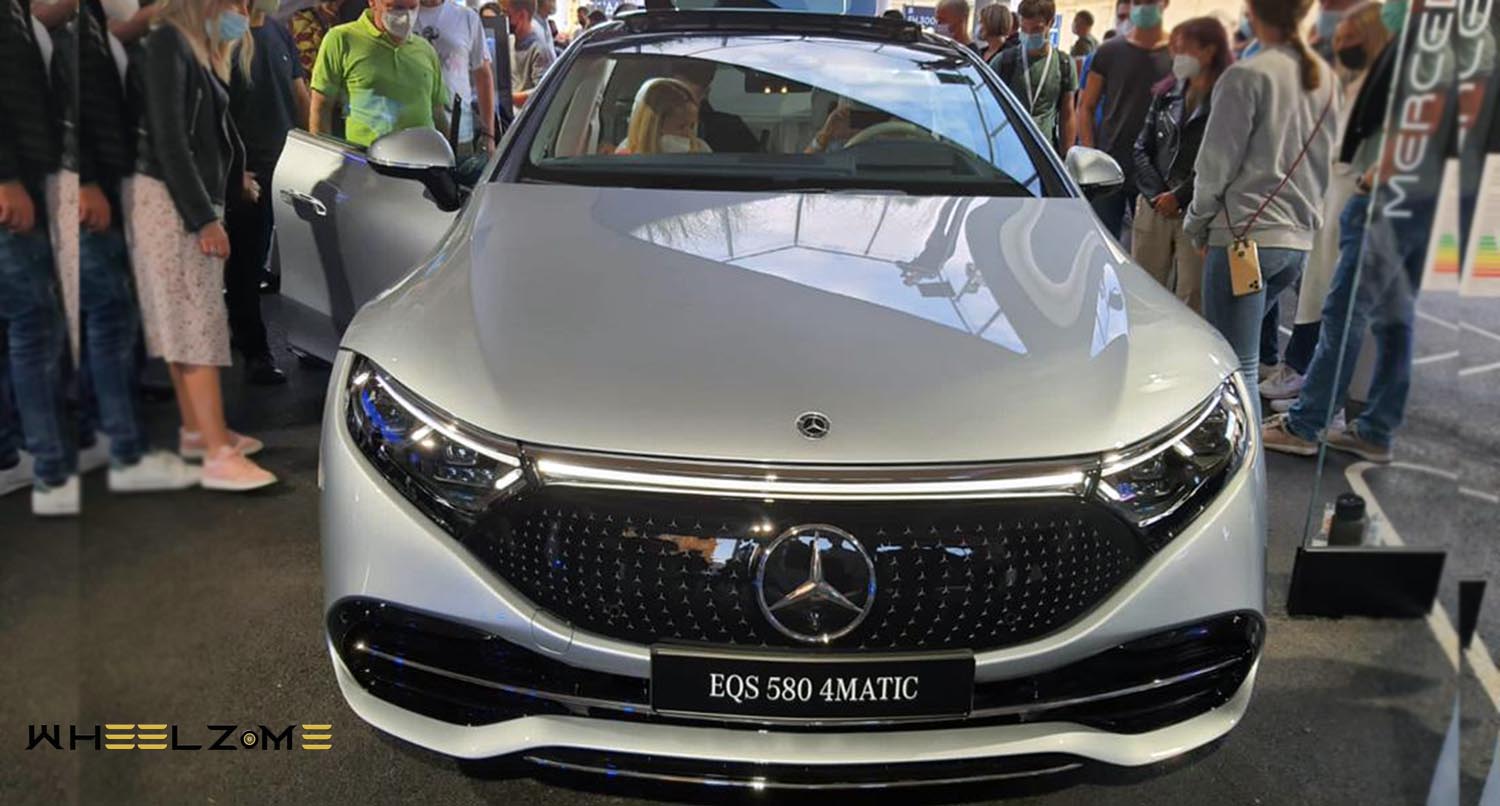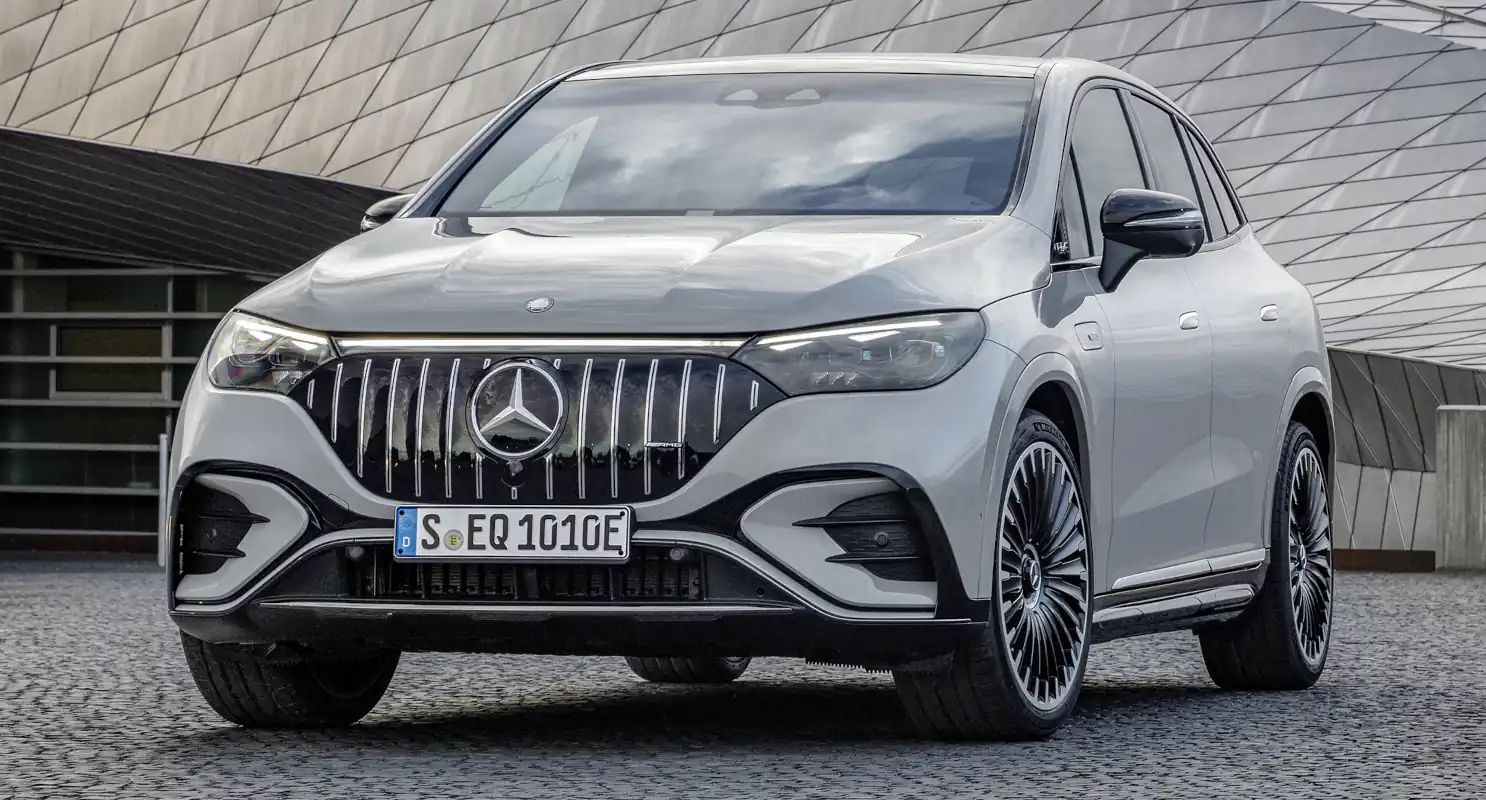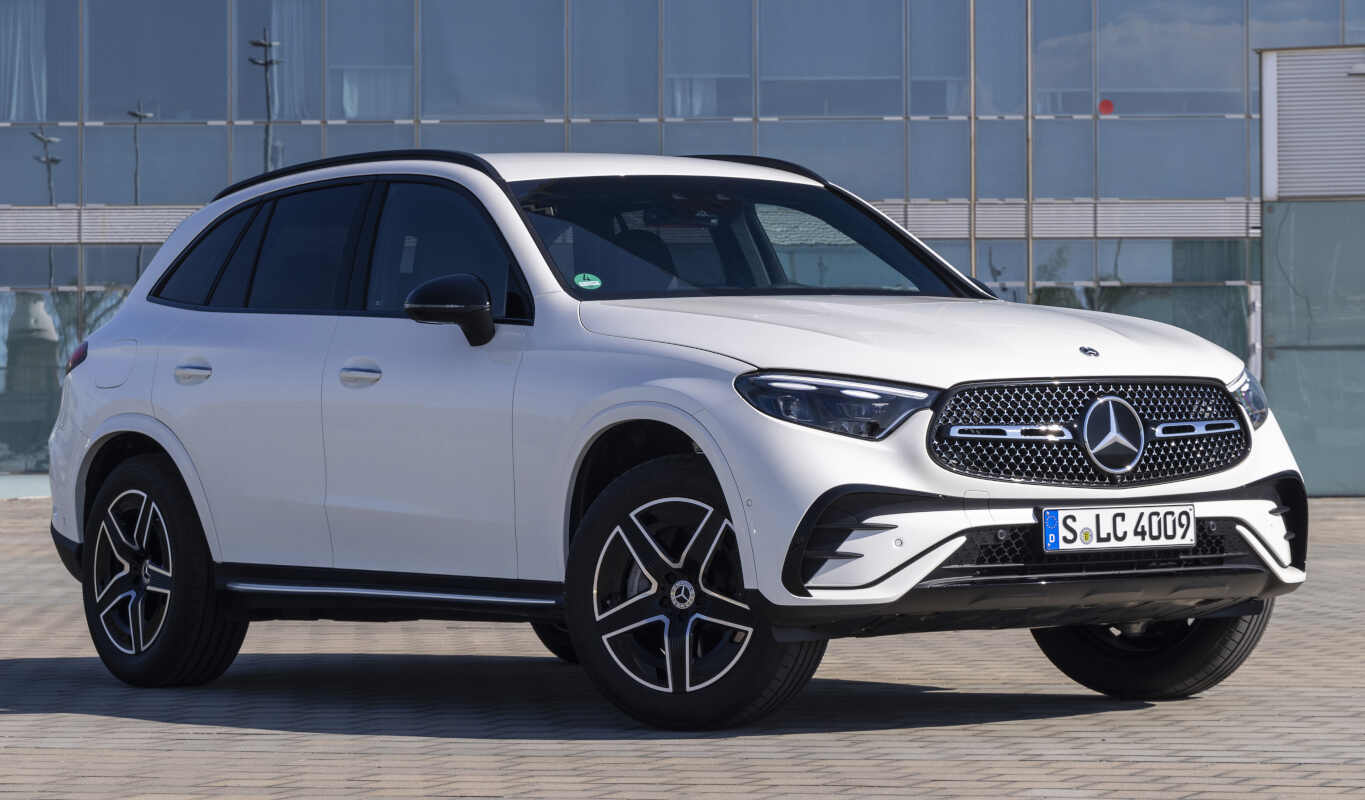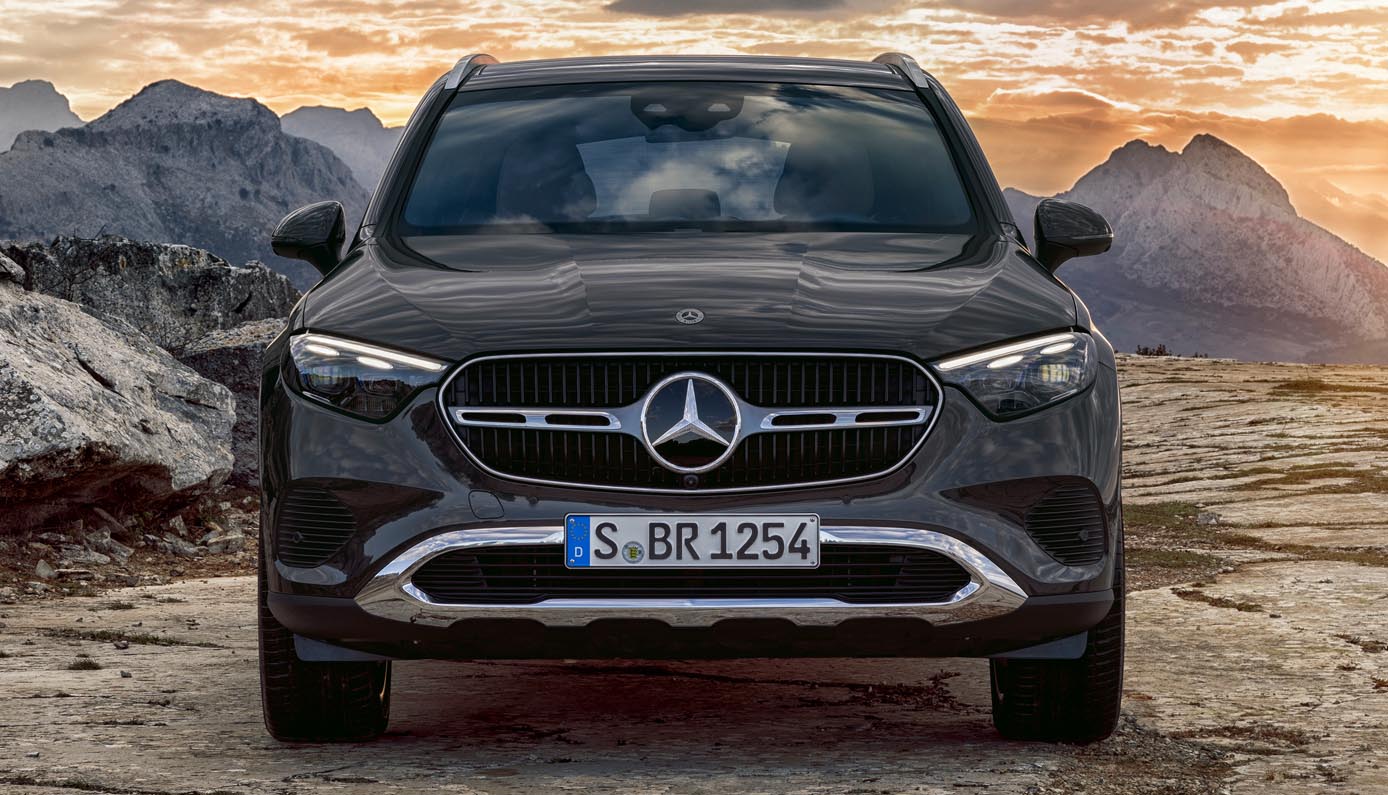
The new Mercedes-Benz GLC is even more dynamic, powerful and sustainable. It is available only as a hybrid: either as a plug-in hybrid or as a mild hybrid with 48-volt technology and an integrated starter-generator. The plug-in hybrids offer a range of more than 100 kilometres (WLTP). The GLC thus sets new standards in the all-wheel drive SUV segment. Systematic electrification of the GLC, the company’s best-selling model series, makes a significant contribution to reducing the CO2 balance over the entire lifecycle. The new GLC is on the way to climate-neutral mobility, which is the goal of “Ambition 2039”. The technical highlights of the GLC also include special equipment such as DIGITAL LIGHT, rear-axle steering and new assistance systems. Its pronounced off-road suitability is underlined by features such as electric off-road driving in the plug-in hybrids, or the “transparent bonnet”. The GLC will be in the showrooms of our western European sales partners from autumn 2022.
The new GLC is immediately recognisable as a member of the Mercedes-Benz SUV family. Standard equipment includes the AVANTGARDE Exterior Line with Chrome package and 18-inch light-alloy wheels. This adds striking design features and enhances the unique proportions of the vehicle.
Exterior design: Expressive highlights
One of the defining design highlights of the Mercedes-Benz GLC is the redesigned front end, with headlamps that connect directly to the radiator grille to emphasise the vehicle’s width. DIGITAL LIGHT headlamps with additional daytime driving light ellipses and new blue trim, plus active floor lighting, are available as optional extras. The typical Mercedes SUV radiator grille with redesigned cut-out has a chrome surround. This frames a sporty louvre in matt grey with chrome trim and the grille with vertical louvres in high-gloss black. From the AMG Line upwards, a radiator grille with Mercedes-Benz pattern is available: a three-dimensional star pattern with high-gloss chrome surfaces. The new simulated underguard in chrome at the front emphasises the vehicle’s width and accentuates the off-road look.
The body design is characterised by a full, spanned surface design enriched with precisely shaped edges in the sides. These emphasise the proportions as well as the muscular wheel arches, and also create a balance between elegance and off-road performance. Wheel arch liners in the vehicle colour are available from the AMG Line upwards for the first time. These accentuate the sportiness of the AMG Line. Also available as an optional extra are easy-entry running boards and the Night package.
Other features of the sporty, confident appearance are the wide track and flush wheels in 18- to 20-inch size. Several of the wheels available ex factory not only feature a modern design with a high-sheen finish and bicolour surfaces, but are also aerodynamically optimised.
The new two-section rear lights with a handle strip in high-gloss black emphasise the width of the rear. Their interior has a three-dimensional look, and as an optional extra they are available with an animation. The rear end also has a simulated chrome underguard, which encases the simulated chrome-look tailpipes.
Interior design: Modern, sporty luxury
Welcome to the modern, sporty luxury of Mercedes-Benz: this is the message the interior of the new GLC with the AVANTGARDE Line already sends out in its standard configuration. It continues the familiar, successful concept, adopting highlights and developing them further with its own keynotes.
The dashboard is clearly structured: the upper section has a wing-like profile with new, flattened round nozzles reminiscent of the engine nacelles of an aircraft. The lower section has a generous trim area that flows harmoniously into the curved centre console. Its orientation towards the driver contributes to sportiness: the dashboard is slightly angled towards the driver by six degrees.
There is a free-standing, high-resolution LCD screen in front of the driver. It appears to float in front of the wing profile and trim area. This sets the driver’s display apart from traditional cockpits with classic dial instruments. It has a size of 12.3 inches (31.2 centimetres).
A high-quality chrome insert divides the centre console into a rear, softly padded area for the armrest and a front area in glossy deep black. The central display rises seamlessly and seemingly without joints from this three-dimensional surface. It appears to float above the trim area.
The central display also makes the paradigm shift towards digitisation clear: the vehicle functions can be controlled using the high-quality touchscreen. Its portrait orientation is particularly advantageous for navigation. Like the dashboard, the screen surface is slightly angled towards the driver. The central display has a screen diagonal of 11.9 inches (30.2 centimetres). Ergonomically located below the central display is a fingerprint scanner. A colour head-up display can be ordered as optional equipment.
The modern, highly reduced design of the door panels frames both ends of the dashboard. The door centre panel with integrated armrest evolves from a vertical surface into a horizontal orientation. Reflecting the design of the centre console, the front section takes the form of a metallic high-tech element. It can be used as a grab or closing handle, and houses the power window controls. Another highlight is the floating control cluster, into which the door opener and seat adjustment controls are integrated.
The avant-garde seat design of the new GLC plays with layers and contoured surfaces, lending them visual lightness. The head restraints and their connection to the backrest with an enclosed cover have been redesigned. The new GLC is available with a leather-lined dashboard with nappa-look beltlines (optional, standard for the AMG Line). Some trim elements have innovative surfaces. These include new interpretations of open-pored veneers in brown tones as well as an open-pored, black wood veneer featuring fine, form-following inlays in real aluminium. On request, direct ambience lighting with light guides replaces the standard indirect ambience lighting.
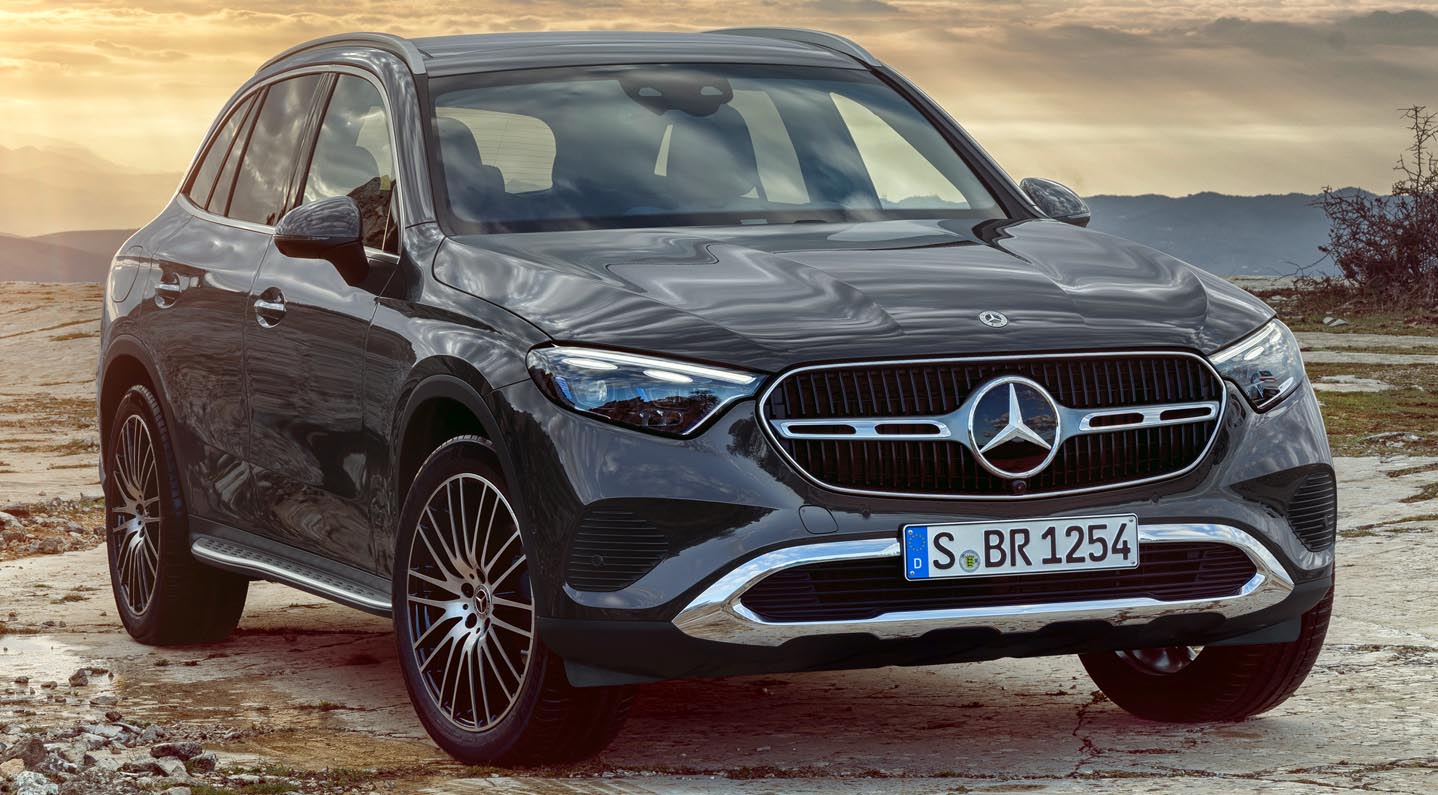
Intuitively operated and learn-capable: Latest generation of MBUX
After the S-Class and C-Class, the new GLC also receives the second generation of the MBUX (Mercedes-Benz User Experience) infotainment system. The vehicle interior becomes even more digital and intelligent as both the hardware and software have made great strides: on the LCD screens, brilliant images make it easy to control vehicle and comfort functions.
The driver and central display offer a holistic, aesthetic experience. The information is presented in a clearly structured way. The appearance can be individualised with a total of three display styles (classic, sporty, discreet) and three modes (navigation, assistance, service). In addition, the GLC offers the off-road mode.
- In “classic” style, the driver is welcomed with a familiar display environment. The proven display of two tubes and alternating content in between provides all driving-related information.
- In “sporty” style, the colour red dominates and the central rev counter is dynamically presented.
- In “discreet” style, the content is reduced to what is essential. In addition, the two screens can be shown in seven colour schemes with the ambience lighting. This creates an impressive colour experience in the interior.
- The “assistance” mode displays the traffic situation in real time and supplements it with important display information.
- The new “off-road” mode makes it possible to visually experience specific content such as gradient, inclination, compass and steering angle and, in conjunction with the optional 360-degree camera, offers the “transparent bonnet” function.
Full-screen navigation offers the driver the best possible guidance while driving. Augmented Video is available as optional equipment. A camera registers the surroundings in front of the vehicle. The central display shows the moving images and also superimposes virtual objects, information and markers. These include, for instance, traffic signs, directional arrows, lane-change recommendations and house numbers. This can make navigation much easier, especially in urban areas.
Hey Mercedes: The increasingly clever voice assistant
The voice assistant Hey Mercedes becomes more interactive and capable of learning with the activation of online services in the Mercedes me App. Moreover, certain actions can be performed even without the activation keyword “Hey Mercedes”. These include taking a telephone call, for example. Hey Mercedes also explains vehicle functions with the voice command “Help”, and provides assistance, e.g. when you want to connect your smartphone via Bluetooth or are looking for the first-aid kit. Hey Mercedes can even recognise occupants by their voices.
Newsflash: Personalised news in MBUX
With the extension of the voice assistant Hey Mercedes to include the new, free-of-charge “Newsflash” feature, Mercedes-Benz customers in the new GLC are always up to date with the news. With the help of the Mercedes me App, they can configure their own, very personal newsflash, and not only specify their favourite categories, e.g. business, sport or culture. They can also choose their preferred news sources, e.g. “BBC News”, “Kicker” or “Wall Street Journal”. A voice command is then sufficient for MBUX to issue a brief news report of up to two minutes in length. Customers preferring not to personalise the App receive a standardised selection of news.
Smart Home: Mobile intelligence for maximum operating convenience from a distance
With the MBUX Smart Home function, the GLC now becomes a mobile control centre for the home. Generally speaking, “smart home” refers to making the home increasingly intelligent and communicative by means of Wi-Fi, sensors and actuators: temperature and lights, shutters and electrical appliances can be remotely monitored and controlled. Motion detectors and window contacts inform the user of welcome or unwelcome visitors.
“Hey Mercedes, is there anybody in my home right now?” “I checked. The last movement detected was in the kitchen one hour ago.” In future, for example, dialogues can be conducted via the MBUX (Mercedes-Benz User Experience) voice assistant between the driver or passenger in the GLC and the user’s smart home. As of the market launch, the MBUX Smart Home function will support numerous devices offered by major smart home providers – corresponding contracts have already been concluded with Bosch Smart Home and Samsung SmartThings. Further providers will follow, and will be announced at a later stage. Right from the start, Hey Mercedes understands questions and commands in four languages (German and Chinese as well as American and British English). Lamps, sockets, thermostats, shutters and blinds, motion detectors, door and window contacts and temperature sensors can be addressed. So the system can also answer this question: “Did I remember to turn the heating down?” Depending on the response and the thermostats installed in the home, it is possible to change the setting: “Set the temperature to 18 degrees in the whole house!” It also enhances comfort because the heating can also be remotely turned up again in good time.
Music: Streaming and sound systems
With the “Online Music” service, Mercedes-Benz has fully integrated the largest music streaming providers into the MBUX infotainment system. MBUX allows seamless access to the personal user profile at the linked music provider. In this way, customers not only have convenient access to their favourite songs and their own playlists, but also the opportunity to discover millions of songs and curated playlists. Operation is intuitive using the MBUX voice assistant, touch controls on the steering wheel or directly on the central display. In addition to the standard sound system with a front bass woofer and four mid-range speakers, optional extras are available:
- Advanced Sound System. This comprises nine speakers – five mid-range, two tweeters, two front bass speakers with 2 x 50 watts from an auxiliary amplifier and a total output power of 225 watts.
- Burmester® surround sound system, specially configured for the GLC by this sound specialist. It comes with a total of 15 premium speakers: seven 50-watt mid-range speakers, four 20-watt tweeters, two 20-watt 3D speakers and two premium front bass speakers with 120 watts each. A 15-channel amplifier drives all speakers fully actively with a total output of 710 watts. In addition, high-quality sound presets, optimisation via a digital signal processor, individual sound settings and staged operation bring the system to life. The metal speaker grilles bear the Burmester® lettering.
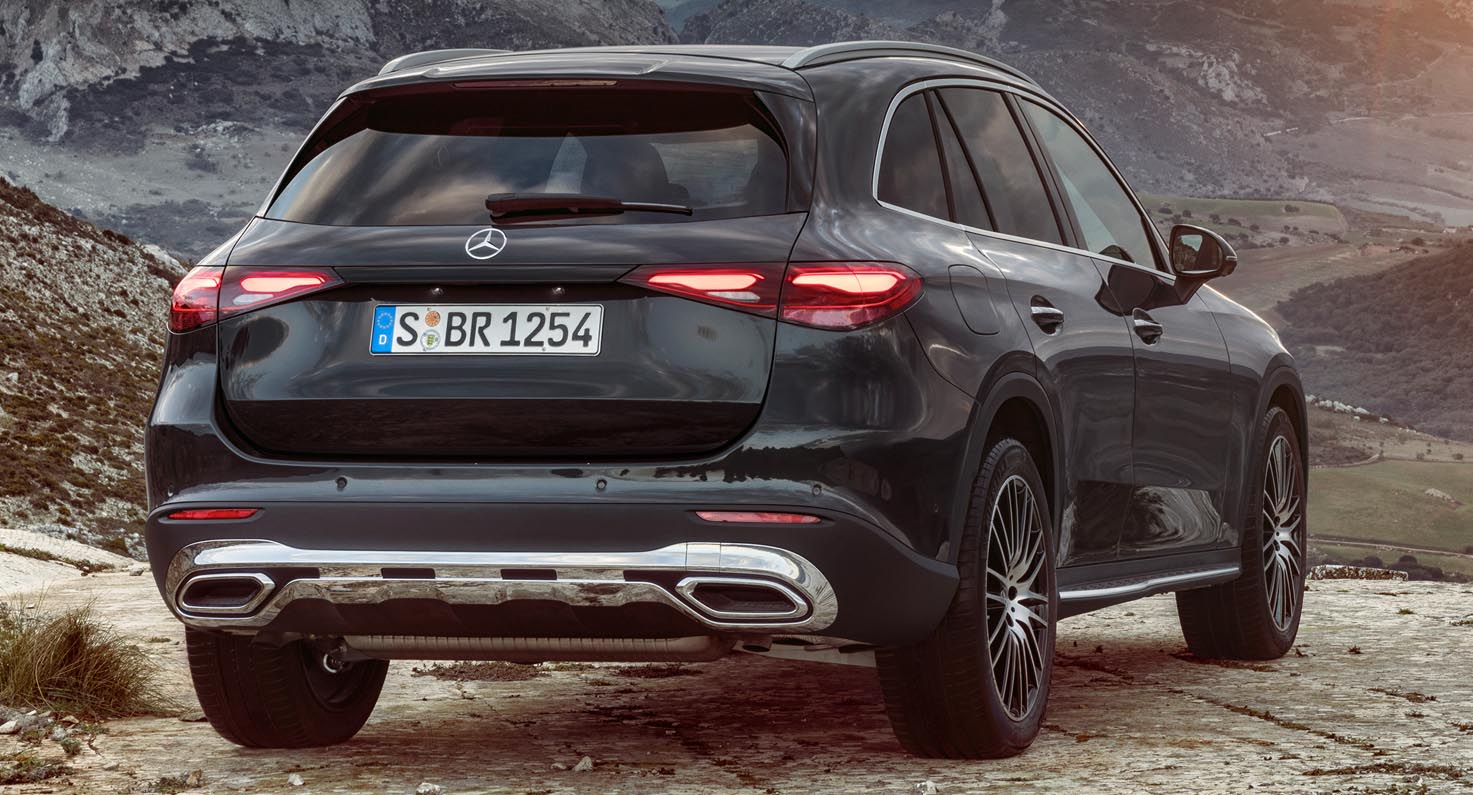
Further highlights: Head-up display and fingerprint sensor
A colour head-up display can be ordered as optional equipment. The driver is presented with a virtual image measuring 9 x 3 inches (around 23 x 8 centimetres) floating a good 3 metres ahead of the bonnet. This is roughly equivalent to a 25-inch monitor. The head-up display consists of a full-colour display module with a native resolution of 800 x 480 pixels, illuminated by high-power LEDs. A mirror optics unit projects the virtual image onto the windscreen and into the driver’s field of vision. Sensor-controlled, the display brightness automatically adjusts to outside conditions.
With the fingerprint scanner, users can log in to MBUX quickly, conveniently and securely. Personal settings and data such as favourites, last destinations, behaviour-based predictions, professional calendar entries and emails are protected. Payment processes via Mercedes me are also restricted to authenticated users.
“Over-the-air” (OTA) updates: The very latest software
As soon as a new software update is available from Mercedes-Benz, a message appears in MBUX. Download and installation take place in the background. The user must then explicitly agree to activation of the update. This means that the vehicle always remains up to date. Features can also be uploaded to already sold vehicles by means of over-the-air updates. For data transmission, Mercedes-Benz relies on the high security standard provided by mobile radio technology and the communication module installed in the vehicle.
Another way to an updated and improved user experience is to additionally book new features in the Mercedes me Store, such as music streaming or in-car office functions. Subscription services can also be renewed or rebooked directly online via the Mercedes me Store.
Powertrain: More electric than ever
The new Mercedes-Benz GLC is available only as a hybrid: either as a plug-in hybrid or as a mild hybrid with 48-volt technology and an integrated starter-generator. The engine range has four-cylinder units from the current FAME (Family of Modular Engines) Mercedes-Benz engine family. Accordingly, the engine range plays a major role in the flexibility of the international production network, with needs-based electrification. The power spectrum of the four-cylinder engines ranges up to 190 kW and 400 Nm of torque in the petrol models, and up to 195 kW and 550 Nm in the diesel models, each plus up to 17 kW and 200 Nm of electrical support from the ISG.
Systematic electrification means:
- All the drive systems available for the GLC are hybrids.
- Four of these are mild-hybrid units, which receive intelligent support in the low rpm range with an integrated second-generation starter-generator (ISG) in conjunction with a 48-volt electrical system.
- Three further engine variants are plug-in hybrids, including an all-electric driving mode and a range of more than 100 kilometres.
The integrated starter-generator with the petrol and diesel engines provides intelligent support in the low rpm range. In combination with turbocharging, this ensures excellent power delivery. The system includes the 48-volt electrical system, which enables functions such as “gliding”, boost or recuperation and thus significant fuel savings. In addition, the engines start very quickly and comfortably with the help of the ISG so that the start-stop function is almost imperceptible to the driver, as is the transition from “gliding” with the engine stationary to powerful propulsion with engine power. When idling, the intelligent interaction between the ISG and the combustion engine ensures outstandingly smooth running.
Transmission: Automatic is standard equipment
The 9G-TRONIC automatic transmission is standard equipment in all GLC models. This has been developed further for ISG adaptation: the electric motor and the power electronics are accommodated in the transmission housing, and thermal management of both components is carried out via the transmission cooling system. Previously necessary lines are therefore no longer required, which offers advantages in terms of installation space and weight. Moreover, the gearbox has a higher efficiency. Among other things, optimised interaction with the electric auxiliary oil pump reduces the delivery volume of the mechanical pump by 30 per cent compared to its predecessor – good for efficiency. Furthermore, it uses a new generation of the fully integrated transmission control with multicore processor and new design and connectivity technology. In addition to the increased computing power, the number of electrical interfaces has been drastically reduced.
All-wheel drive: Mercedes-Benz 4MATIC
All models of the new GLC come with the latest 4MATIC all-wheel drive system. The new front-axle drive allows higher torque levels to be transferred, with an ideal axle load distribution for driving dynamics. This also has a considerable weight advantage compared to the axle drive of the preceding series. The longitudinal transfer case, which is also new, further reduces friction losses. It also has a closed oil circuit and does not require any additional cooling measures.
Diesel with integrated second-generation starter-generator
The OM 654 M with integrated second-generation starter-generator and 48-volt onboard power supply is at the forefront of efficient drive technology. Recuperation and the possibility to “glide” with the engine switched off further increase efficiency. Apart from electrification including an electric refrigerant compressor for the air conditioning system, these are the most important changes for the output of up to 198 kW plus a boost of 17 kW by the ISG:
- Stroke of 94.3 millimetres and displacement of 1993 cc (previously: 92.3 and 1,950) thanks to new crankshaft
- 2,700 bar injection pressure (previously 2,500).
- Particularly fast response and smooth power delivery thanks to two water-cooled turbochargers, now both with variable turbine geometry.
- Cooling channel filled with sodium in the steel piston for effective reduction of temperature peaks in the piston crown.
These are the exhaust aftertreatment components for the diesel:
- A close-coupled NOx storage catalytic converter to reduce nitrogen oxides.
- A diesel particulate filter (DPF) with special coating, also to reduce the nitrogen oxides.
- A near-engine mounted SCR (Selective Catalytic Reduction) catalytic converter with metered injection of AdBlue®).
- An additional SCR catalytic converter in the vehicle’s underbody, with a separately metered injected quantity of AdBlue®
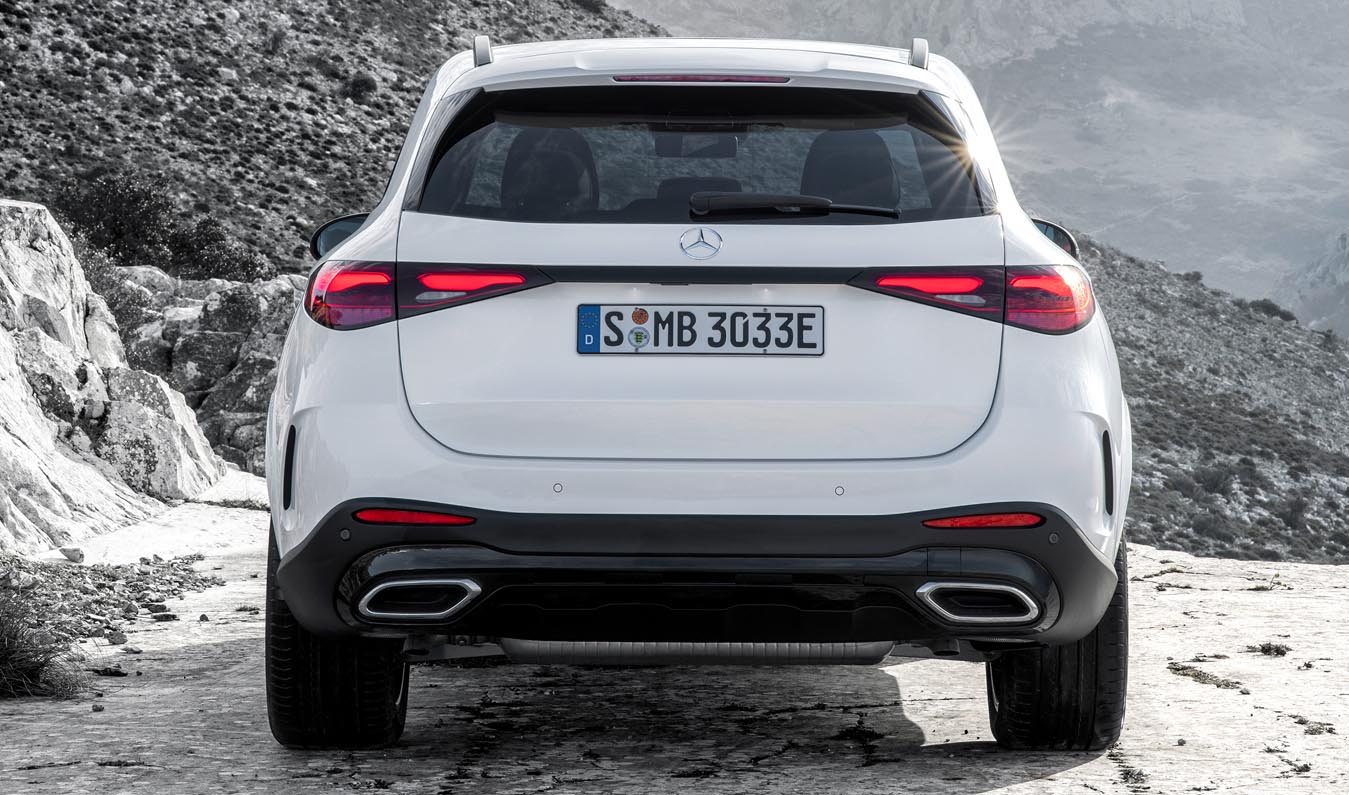
Four-cylinder petrol engine with second-generation ISG
After the C-Class, the new GLC is the second Mercedes-Benz model series to receive the four-cylinder M 254 petrol engine with integrated second-generation starter-generator (ISG). The ISG provides up to 17 kW of additional power and 200 Nm more torque, can recuperate higher electrical outputs than a belt-driven starter generator, shifts the load point of the combustion engine and allows hybrid functions such as “gliding” with the engine switched off, boosting and recuperation. This makes the petrol engines very efficient. In the M 254, Mercedes-Benz has also combined all the innovations of the modular engine family of four- and six-cylinder petrol and diesel engines in a single unit. They include NANOSLIDE® cylinder coating, CONICSHAPE® cylinder honing (trumpet honing) and the exhaust aftertreatment system positioned directly at the engine. All the engines are characterised by superior power delivery, smooth running and excellent noise comfort.
The segmented dual-flow turbocharger has been completely redeveloped as a further development of the twin-scroll technology for an even more spontaneous response. This turbocharger is the result of collaboration between Mercedes-Benz turbocharger development and the Mercedes-AMG Petronas Formula One team. The technology transfer to series production sets new standards in terms of performance combined with maximum efficiency.
Plug-in hybrids: An electric range of more than 100 kilometres (WLTP)
The Mercedes-Benz GLC also receives the fourth-generation plug-in hybrid drive in three power levels. Using the identical basic engines, electrification has taken another big step. With an electric drive power of up to 280 kW (381 hp) and an all-electric range of more than 100 kilometres (WLTP), the plug-in hybrid models of the GLC will in many cases and on many days be on the road purely electrically, without the use of the combustion engine. Whether with one of the two petrol engines or the diesel: as plug-ins, they are not only very efficient but also extremely dynamic on the road. The plug-in models come with AIRMATIC air suspension including level control at the rear axle as standard.
The new high-voltage system is more compact and more powerful. The number of high-voltage interfaces is significantly reduced. Integration of the power electronics into the transmission housing reduces the required installation space and simplifies assembly processes in production. In addition, a higher system voltage increases the drive power without the need for larger cable cross-sections.
The high power density of the hybrid drive unit comes courtesy of a permanently excited internal rotor synchronous motor. The 440 Nm peak torque of the electric motor is ready to go right from the start, resulting in high agility when moving off, along with dynamic driving performance. The full electric power is available up to 140 km/h.
The high-voltage battery is an in-house development by Mercedes-Benz. In particular, the total capacity of 31.2 kWh in combination with more efficient recuperation and improved aerodynamics allow an all-electric range of more than 100 kilometres. To accommodate the high power density, the high-voltage battery has an internal cooling system. The thermal management system can therefore control the operating temperature irrespective of the climate control in the vehicle interior. In addition to continuous operation in hot and cold regions, this also allows quick charging with direct current.
Even if the battery is completely drained, it is possible to effect a full recharge with the optional 60 kW DC charger in around 30 minutes. A standard-fit 11 kW charger (depending on the market) is available for three-phase charging at a Wallbox connected to the domestic AC mains. The standard charging cable can be stored within easy reach in a floor compartment just behind the tailgate.
Everyday routes: Electric of course
All in all, the driving experience is significantly more electric. Thanks to the increase in electric range to more than 100 kilometres, everyday journeys can largely be covered purely electrically. The improved hybrid driving programme provides electric driving mode for the most suitable sections of the route. Electric driving is prioritised on longer journeys in urban areas, for example.
Recuperation recovers kinetic energy when decelerating or driving downhill by operating the electric motor as a generator during overrun and braking. The electrical energy generated by the vehicle’s kinetic energy is stored in the high-voltage battery and can be used for electric driving. In the new GLC, the interaction with the hydraulic brake has been significantly optimised: Mercedes-Benz uses a vacuum-independent, electromechanical brake booster. Depending on the driving situation, this automatically controls the flexible transition between hydraulic braking and recuperation, and thus always ensures the best energy recovery. As a result, the maximum recuperation power of up to 100 kW can be achieved more frequently than with a conventional, purely hydraulic braking system. This significantly improves the overall efficiency of the hybrid system, and benefits the electric range.
A driver wishing to influence the energy recovery rate can do so directly in three stages controlled by rocker switches behind the steering wheel. This is possible in all driving modes except SPORT. In driving mode D, for example, the driver can experience the “one-pedal feeling”: when the driver takes their foot off the accelerator, the vehicle slows down purely electrically to the extent that the hydraulic operating brake is often not needed. In addition the operating strategy communicates with the sensors of the assistance systems, efficiently supporting the driver in many situations.
Two driving modes allow the driver to use the possibilities of the plug-in drive in a particularly targeted manner:
- BATTERY HOLD: Priority is given to preserving the charge state of the high-voltage battery, e.g. when driving in a city centre or low-emission zone is planned for later on. The hybrid drive system selects the appropriate drive depending on the driving situation and distance.
- ELECTRIC: Electric driving up to 140 km/h, adjustable overrun recuperation, activation of the combustion engine by the pressure point of the accelerator.
If the route-based operating strategy is activated in both driving modes, data on the expected route is evaluated when route guidance is active. This takes into account factors such as navigation data, topography, speed limits and the traffic conditions for the entire planned route. With the route-based operating strategy, the two forms of energy of the hybrid vehicle can be distributed in the best possible way. The drive control automatically selects the most suitable operating mode so that the state of charge of the high-voltage battery can be specifically influenced. For example, electrical energy can be saved for e-driving so that it is possible to drive all-electrically in inner-city areas or in environmental zones later on.
In the HYBRID and ELECTRIC driving modes, as well as in BATTERY HOLD, the ECO Assistant also evaluates the route data and supports the greatest possible efficiency and recuperation energy according to the route. If the navigation map or sensors and cameras detect an upcoming roundabout, a hairpin bend, a tight bend, a T-junction, a gradient, a vehicle in front or a speed limit, for instance, the ECO Assistant calculates the optimum vehicle speed based on the distance, speed and gradient.
The plug-in hybrid variants of the new GLC have a haptic accelerator pedal module. In the ELECTRIC driving mode, this signals the change from electric driving to driving with the combustion engine by means of a perceptible pressure point. If the pressure point is exceeded, the combustion engine is switched on and provides additional drive torque.
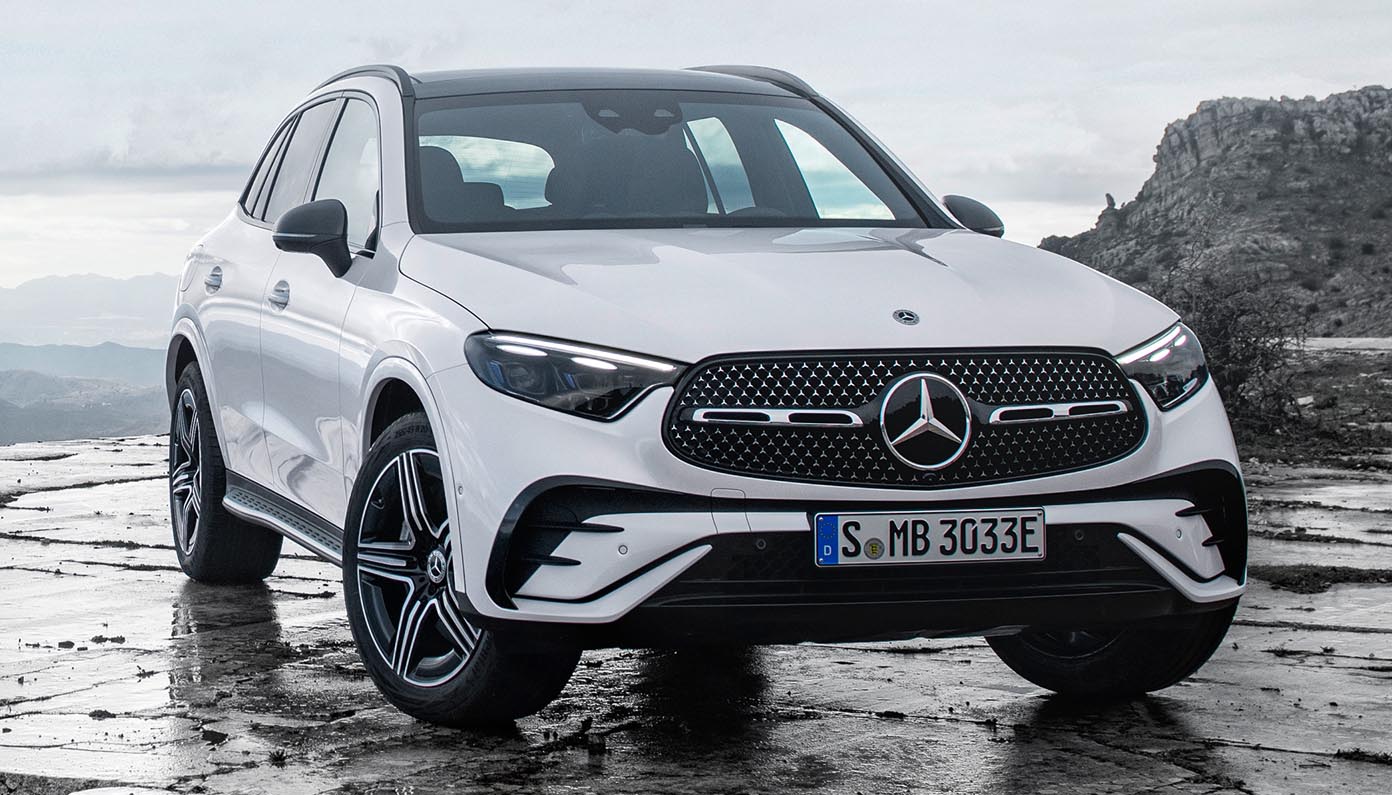
Suspension: Comfort and agility
Key components of the GLC’s dynamically designed suspension system are a new four-link suspension at the front and a multi-link independent rear suspension mounted to a subframe. The standard suspension already provides a high level of suspension, ride and noise comfort, agile handling and driving enjoyment. It is equipped with an amplitude-dependent damping system.
As an option, the new GLC is available with the Engineering package, which includes AIRMATIC air suspension and rear-axle steering. AIRMATIC is equipped with variably adjustable damping for compression and rebound. The plug-in hybrids have air suspension and level control at the rear axle as standard. Another optional extra is the Offroad Engineering package, which increases ground clearance by 20 millimetres and has an underride guard at the front and underbody protection. In conjunction with the AMG Line Exterior, the GLC has a sport suspension.
Rear-axle steering: More agile and dynamic
The new Mercedes-Benz GLC is particularly agile and stable with the optional rear-axle steering combined with a more direct steering ratio at the front axle. The steering angle at the rear axle is up to 4.5 degrees. This reduces the turning circle by 80 centimetres to 11.0 metres. The driver also needs fewer turns of the steering wheel from lock to lock.
At speeds of less than 60 km/h, the rear wheels steer in the opposite direction to the front wheels – when parking, by up to 4.5 degrees counter to the front axle angle. Depending on the situation, this virtually shortens the wheelbase, and the vehicle is more light-footed and agile as a result. When the speed reaches 60 km/h or more, the rear wheels steer in the same direction as the front wheels by up to 4.5 degrees. The resulting, virtually extended wheelbase offers noticeable advantages in handling stability and driving safety at high speeds, and during fast lane changes or sudden evasive manoeuvres.
In addition, during dynamic manoeuvres such as driving on a country road, significantly less steering movement is required – and the vehicle responds more directly to steering commands. This is supported by the integrated dynamic control function of ESP®.
Driving assistance systems: Stress-relief and support in hazardous situations
The latest generation of the Driving Assistance package contains additional and further improved functions. These reduce driver workload in day-to-day situations for more comfortable and safe driving. When danger threatens, the assistance systems are able to respond to impending collisions as the situation demands. The operating principle of the systems is visualised on the driver display by a new display concept.
Further improved assistance systems – some examples:
- On all types of roads – motorways, country roads or in town – Active Distance Assist DISTRONIC can automatically maintain a preset distance to vehicles in front. A new feature is the ability to react to stationary vehicles on the road at speeds up to 100 km/h (previously: 60 km/h).
- Active Steering Assist helps the driver to stay in lane at speeds up to 210 km/h. New features: lane detection using an additional 360-degree camera, with particular advantages in the low speed range, e.g. when forming an emergency lane; significantly increased availability and cornering performance on country roads; increased lane centring on motorways.
- In addition to conventionally posted speed limits, Traffic Sign Assist recognises signs on overhead gantries and at roadworks. The system recognises even conditional signs, e.g. “in wet conditions”, by evaluating all vehicle sensors. New are the stop sign and red light warning function (as part of the Driving Assistance package).
- The new Parking package with 360-degree camera offers the best all-round visibility and facilitates the parking process e.g. with assisted parking and unparking. The “transparent bonnet” now included as a new function makes slow manoeuvring easier, and makes for more precise driving on rough terrain.
Sophisticated parking systems: Support during slow manoeuvres
Thanks to more powerful environment sensors, the parking systems can better support the driver when manoeuvring, thus improving safety and comfort. Integration into MBUX makes operation more intuitive and is supported by the visual display. The optional rear-axle steering is integrated into the parking assistants, and calculation of the lanes (trajectories) is coordinated accordingly. Emergency braking functions also serve to protect other road users, and can increase road safety.
The Parking package with 360-degree camera and “transparent bonnet” and the functions of Active Parking Assist with PARKTRONIC is available as an optional extra. It offers the best possible all-round visibility and facilitates the parking process. The central display clearly shows the direct vehicle surroundings during the parking or manoeuvring process. The display is composed of four individual camera images from the front, rear and both sides of the vehicle, and includes a virtual bird’s eye view. In addition, the display shows different viewing angles such as front, rear or trailer mode. The driver decides whether to park manually or hand control over to Active Parking Assist.
Over hill and dale: Off-road with the GLC
Like its predecessor, the new Mercedes-Benz GLC is explicitly designed for driving on rough terrain: it is prepared for this use in numerous details, and also offers several new features and systems. Standard equipment includes an off-road driving mode and DSR (Downhill Speed Regulation). The new off-road screen has easier operation, there is clearer information thanks to the “transparent bonnet” and outstanding traction and handling safety by virtue of improved control systems. With the plug-in hybrid models, purely electric off-road operation is possible even over long distances. With these, the driver can choose between off-road driving with purely electric or conventional drive.
The new off-road screen uses the two displays for clearly arranged information. Among other things, the driver’s display shows inclination, gradient, topographical altitude, geo-coordinates and a compass as well as road speed and engine speed when operation is with an internal combustion engine. Moreover, the central display shows, for instance, the current position of the SUV on the terrain with uphill/downhill gradient and inclination, the steering angle of the front wheels and, if rear-wheel steering is available, the steering direction of the rear wheels in addition to – with AIRMATIC – the current suspension level and the current wheel deflection. It also shows the tyre pressure, tyre temperature, current torque and output, and the engine and transmission oil temperature.
The Engineering package (optional) with AIRMATIC air suspension including level control and rear-axle steering also brings its comfort advantages to bear when off-road, where it offers additional benefits. For example, AIRMATIC allows a high ground clearance off-road, regardless of the load, and a long suspension travel for the best possible traction. The rear-axle steering increases off-road manoeuvrability even further. Alternatively, the off-road suspension (part of the Offroad Engineering package) with 20 millimetres more ground clearance is also available as an optional extra.
If the vehicle is equipped with DIGITAL LIGHT, an off-road light is also included. This provides maximum, wide illumination when driving on rough terrain, and makes for accurate and safe manoeuvring around obstacles in unfamiliar environments.
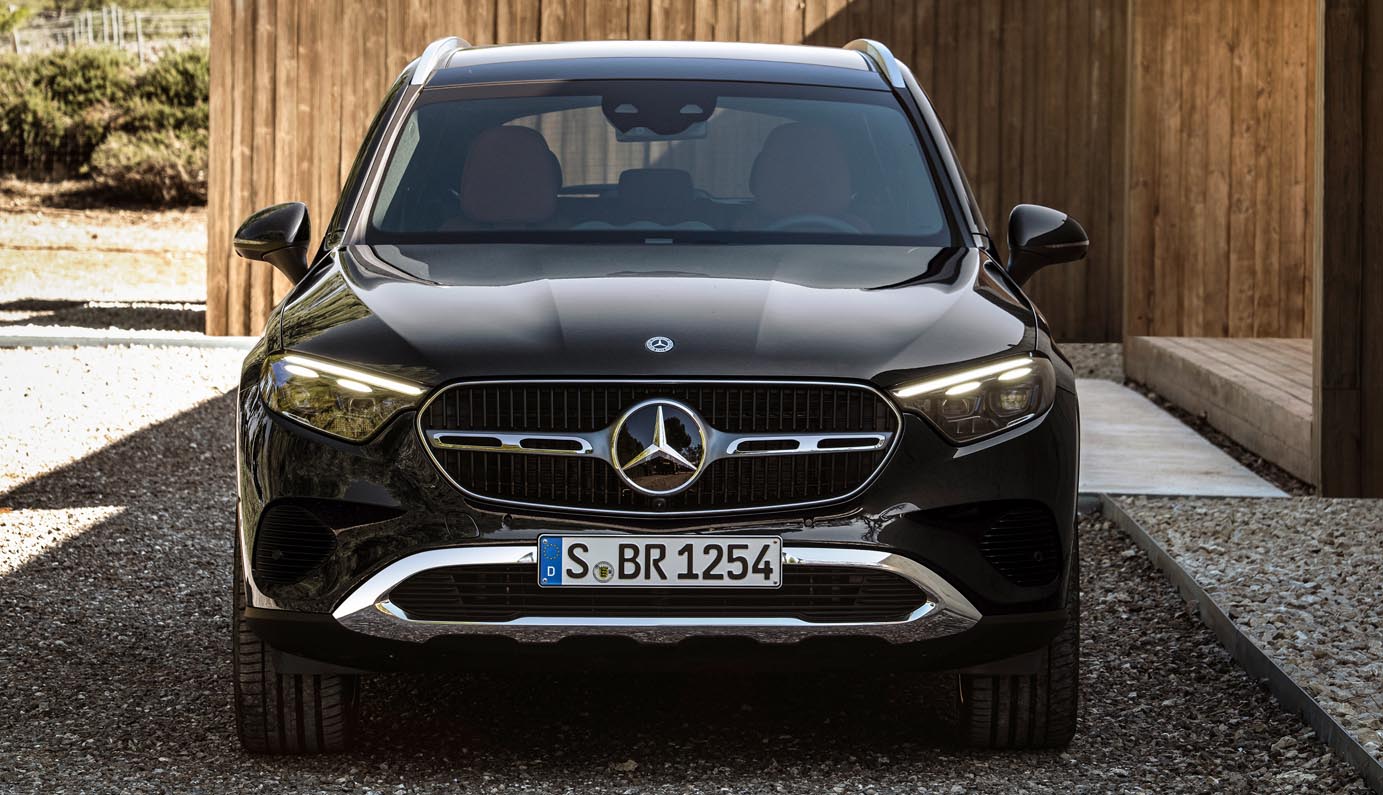
View beneath the vehicle: “Transparent bonnet”
The GLC also offers a “transparent bonnet”: when the off-road mode is active, the central display shows a virtual view under the front of the vehicle, including the front wheels and their steering position. The view is composed of the images from the 360-degree camera. There are two views: under the vehicle and looking ahead. At speeds up to 8 km/h the “transparent bonnet”, i.e. the view under the vehicle, is shown. From 8 to 20 km/h the system shows the view ahead. The camera image is switched off at higher speeds. The “transparent bonnet” is extremely helpful: it enables the driver to recognise obstacles such as large stones or deep potholes in their path at an early stage. The optional Parking package with 360-degree camera is a prerequisite for the “transparent bonnet”.
Off-road electric: Very powerful and efficient
The plug-in models of the new GLC already offer a driving experience of the future: all-electric off-road driving. This has many advantages: since the electric motor’s full torque of 440 Nm is available from the very first engine revolution, its power is very easy to control at all times. This allows highly precise, controlled driving even on difficult terrain. In addition, because the electric motor only consumes energy when it is actually moving the vehicle, and the power demand is comparatively low when the vehicle is driven slowly as is usual when off-road, a long all-electric driving time is possible even on demanding terrain. In keeping with the nature of the electric drive, noise emissions are also very low when the vehicle is driven slowly. All this makes for a completely new off-road experience.
Trailer menu and towing route planner
The Mercedes-Benz GLC is a popular towing vehicle, and the new edition is specifically designed for this purpose. The new trailer menu and the towing route planner are two highlights of the GLC for towing operations. The aim of these and numerous further advanced functions for operation as a towing vehicle is to make towing as safe and pleasant as possible. Moreover, the 4MATIC all-wheel drive provides outstanding traction on any surface. In trailer mode, the ESP® trailer stabilisation is activated: This can compensate for dynamic instabilities while the vehicle is being driven.
With the help of the towing route planner, in the central display, routes can be planned that are suitable for driving with the previously defined trailer. For this, the towing route planner takes into account passage widths and passage s, for example. As soon as the ballhead is engaged and an electrical connection exists, the system enquires about the intended use of the trailer coupling: is it a small trailer? Or something larger, such as a caravan or horsebox? Or is a bicycle carrier installed? The towing route planner takes this information into account.
The trailer hitch (optional equipment) has a fully electrically swivelling ballhead. The socket is located in the trailer hitch. In conjunction with Trailer Manoeuvring Assist, the ballhead includes a positioning ring for easier coupling. The image from the reversing camera includes the trailer hitch and the area directly behind it so that the hitching process can be observed on the central display.
The enhanced Trailer Manoeuvring Assist (optional) in the new GLC makes manoeuvring with a trailer even easier, more comfortable and safer. The system automatically regulates the steering angle of the towing vehicle up to a speed of 5 km/h and an uphill gradient of up to 15 per cent. It is also integrated into MBUX and can be operated intuitively. In addition to stabilising the combination when reversing, the system can, for the first time, also guide it around freely selectable bends of up to 90 degrees. The steering of the towing vehicle is operated automatically so that the selected angle is maintained. This allows precise and safe positioning of a trailer. The driver can also select the “pull straight” function when the trailer has reached the desired direction and is to reverse straight. The entire manoeuvring process can be followed from different camera perspectives on the central display. Dynamic guide lines show the trajectory, vehicle width and distance from recognised objects.
High passive safety
The GLC is available on all continents. Whether in right- or left-hand drive, with petrol engine, diesel engine or as a plug-in hybrid: when it comes to crash safety, all models meet the typically high Mercedes safety standards.
Together with the familiar PRE-SAFE® protection concepts for frontal and rear impacts, PRE-SAFE® Impulse Side (available in conjunction with the Driving Assistance package Plus) forms a virtual crumple zone around the vehicle. As only a limited crumple zone is available in a side impact, PRE-SAFE® Impulse Side (availability depending on selected equipment) can move the affected driver or front passenger away from the danger even before the crash as soon as the system detects that a side collision is immediately imminent. For this purpose, air chambers in the side bolsters of the front seat backrest are inflated in fractions of a second.
All in all, the GLC’s safety concept is based on an intelligently designed body with a particularly rigid passenger cell, selectively deformable crash structures and situational interaction between the seat belts, belt tensioners and airbag systems. In addition to legal requirements, the vehicle also fulfils internal Mercedes-Benz test requirements and test criteria that are derived from real accidents.
Extensive crash simulations were used to configure the vehicle structure in such a way that the occupants are particularly well protected in the event of a crash. The bodyshell concept incorporates all areas – front structure, passenger cell, side walls and floor assembly. It is implemented through the design and construction of the body components, a stress-related material mix and appropriate wall thicknesses in highly stressed areas. The overall concept leads to homogeneous load distributions and high energy absorption with moderate deceleration acting on the occupants. In addition, sufficient protective space can be provided for the occupants.
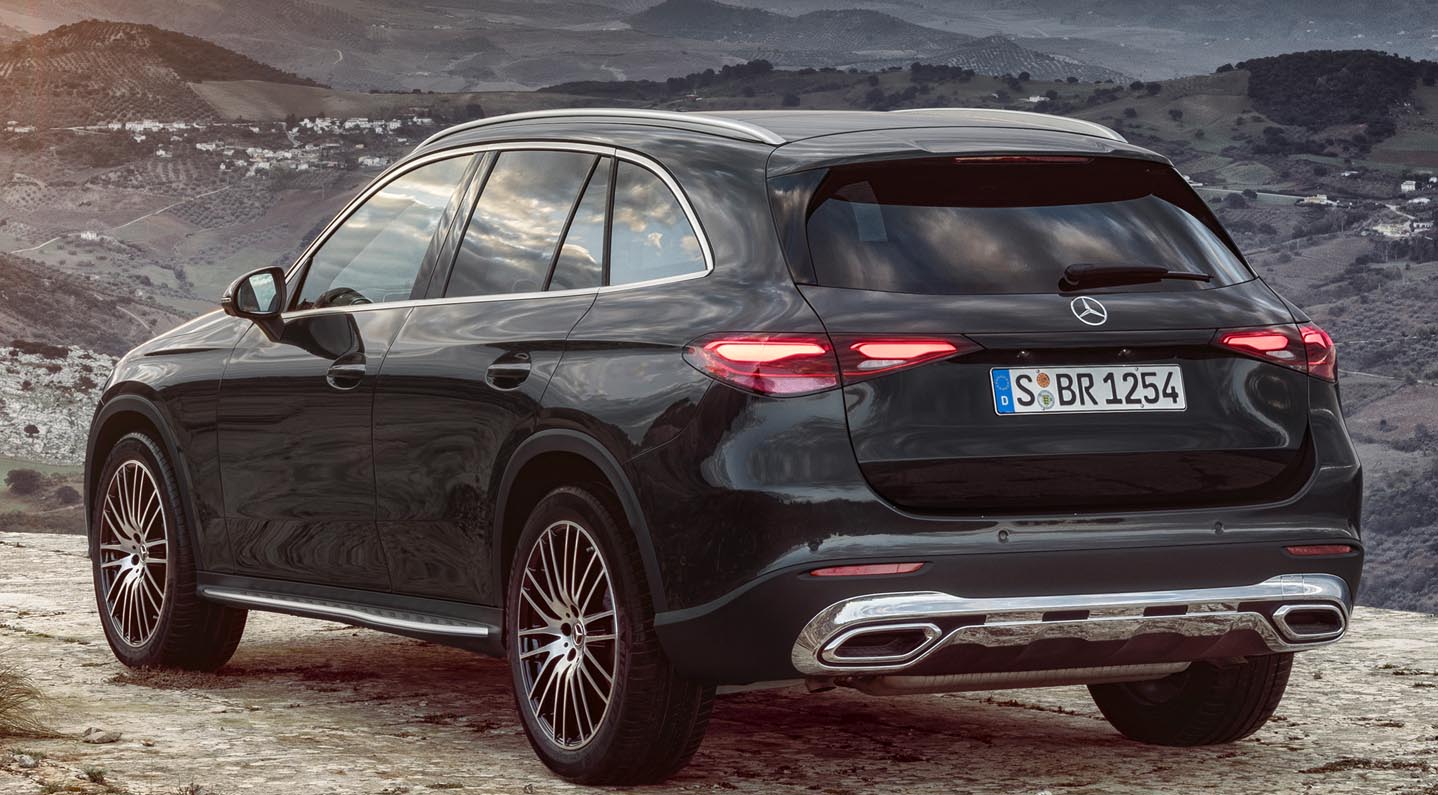
Aerodynamics: Now Cd = 0.29
From around 60 km/h, air resistance exceeds the total of all other driving resistances and is a main control factor for saving fuel and reducing CO2 emissions. The air resistance is significantly influenced by the drag coefficient (Cd) and the frontal area (A). The noise level in the vehicle is also increasingly dominated by wind noise at higher speeds. Optimisation of the vehicle with respect to aerodynamic drag and wind noise was carried out with the help of extensive digital flow simulations (CFD – computational fluid dynamics), as well as tests with real vehicles in the aeroacoustic wind tunnel.
In its aerodynamically most favourable configuration, the minimal drag coefficient of the GLC is Cd = 0.29. This makes it two tenths better than its predecessor (Cd = 0.31) – a notable advance for an SUV with conventional drive. The frontal area is 2.60 square metres. Purely battery-electric vehicles have more possibilities for an even lower level in terms of aerodynamics. Among other things, they have a different cooling air concept for the powertrain so that an airflow through the bodywork can be largely avoided.
Many factors contribute to the improved aerodynamics of the new GLC. The most important measures include the following:
- Air control system with two levels (radiator grille and front apron) with aerodynamically optimised basic ventilation position for maximum aerodynamic performance
- Ideally positioned and aerodynamically/aeroacoustically optimised beltline mirror
- Aerodynamic design of the roof spoiler and integrated side spoilers
- Side spoiler lips in the rear lights
- Optimised wheel spoilers at front and rear
- Aerodynamic cladding on the spring control arms (if steel suspension)
- An optimised underbody panelling concept that is as uniform as possible for the different engine variants
- Aerodynamically optimised wheels
- Aerodynamically optimised suspension lowering in Eco driving mode
Noise comfort: Quiet and pleasant acoustics
The electrification of vehicles means that wind noise is increasingly noticeable as it is no longer masked by noise from a combustion engine. The influence of wind noise on homogeneous acoustics in the vehicle interior is therefore increasing. An optimised airflow around the outer skin of the vehicle, plus high-quality seals and sound insulation, are key factors in reducing wind noise.
The new GLC is a pleasantly quiet vehicle with a serene sound signature and very low rolling and wind noise. This was achieved with acoustic optimisation of the bodyshell and sophisticated sound insulation. An acoustic membrane in the windscreen is standard equipment, for example. The optionally available, acoustically effective thermal insulation glass meets even higher comfort expectations. The driver’s door window is of acoustically effective laminated glass. Detailed fine-tuning further enhances the level of “noise – vibration – harshness” (NVH). All the acoustic measures jointly contribute to the “welcome home” atmosphere that is typical of Mercedes-Benz. Three examples:
- Large parts of the upper bodyshell structure are filled with very light and highly effective acoustic foam. Elimination of the cavities noticeably reduces the noise level compared to the preceding model.
- The metal sheets of the drive tunnel cover and flanks are lined with acoustic material. This NVH technology in the bodyshell particularly reduces noise from the drive system.
- The development work on the bodyshell particularly focussed on rigidity and strength. Among other things, the proportion of ultra-high-strength and hot-formed steels and sheet blanks with variable wall thicknesses (tailored rolled blanks) has been increased compared to the preceding series.
Discreet acoustic feedback indicating the current power delivery additionally enhances the harmonious character of the vehicle. The low, well-balanced exterior noise as well as the acoustics in the interior underline the high perceived value of the new GLC.
General noise optimisation, especially in the high-frequency range, was also achieved through numerous detailed measures. A few examples: modified door and window seal sections; flexible inner door cavity struts for optimum contact with the adjacent window guide rail; reduction of component vibrations in the doors by increasing the structural rigidity of the door body.
Spotlight: The new exterior mirror
As a particularly good example, the exterior mirror illustrates the high development standard of the new GLC with respect to aerodynamics and aeroacoustics. The GLC now has beltline mirrors instead of the previous stem mirrors. The most favourable mirror position on the exterior door panel was identified, and the mirror base was aerodynamically and aeroacoustically improved. The effects are manifold: the air flows around the vehicle with even less turbulence, which improves the Cd figure. In addition, the wind noise at the new exterior mirror is lower so that the side acoustics in the interior are even more pleasant.
What sounds simple in terms of results required extensive consultations between the departments involved regarding every detail, e.g. design, material choice, position and sealing. Right from the early development phase, simulations made a major contribution and provided findings that were directly adopted in the hardware design. Further improvements to the weather seals were made by computer tomography when prototype vehicles became available. The aim was to offer the smallest possible surface to the slipstream, and therefore ensure significantly better overall aerodynamics and aeroacoustics compared to the preceding model.
DIGITAL LIGHT: Extremely powerful with optional projection functions
The new Mercedes-Benz GLC has LED High Performance headlamps as standard. DIGITAL LIGHT is available as an optional extra. This revolutionary headlamp technology allows new functions such as the projection of auxiliary markings and warning symbols onto the road. DIGITAL LIGHT contains a light module in each headlamp, with three extremely powerful light-emitting diodes (LEDs), whose light is refracted and directed with the help of 1.3 million micro-mirrors. This corresponds to a total resolution of more than 2.6 million pixels.
With its dynamics and precision, DIGITAL LIGHT creates almost unlimited possibilities for high-resolution and targeted light distribution according to the ambient conditions. The technology in the headlamp is controlled highly dynamically depending on the situation. Camera and sensor systems in the vehicle recognise other road users, while powerful computers evaluate the data and digital maps in milliseconds and give DIGITAL LIGHT the commands for adapted light distribution in all situations. The result is excellent visibility for the driver, without impairing that of other road users or dazzling oncoming traffic. This also applies to the ULTRA RANGE high beam. The aim here is not to set new records for headlamp range, but to achieve the best possible visibility and brilliance without glare thanks to an innovative overall concept.
DIGITAL LIGHT with projection function is available as an option. This innovation offers extra safety for the driver, especially when driving at night, and allows communication with other road users. A few examples:
- DIGITAL LIGHT can make driving safer by projecting guiding lines, symbols and animations and, for instance, project two guiding lines when passing through roadworks. This marking approximately indicates the width of the vehicle, enabling the driver to negotiate the narrowed lane more easily.
- The intelligent technology highlights pedestrians in the danger zone with a spotlight function and clarifies their position with projected direction points.
- Customers driving the wrong way on motorway entry ramps or in one-way streets are warned by a symbol.
- The same warning symbol appears before the vehicle runs red lights or stop signs.
The DIGITAL LIGHT projection functions that are allowed in different countries can vary. The integrated geofencing helps the driver to comply with legal regulations in every country. When the vehicle crosses a national border, the functions of DIGITAL LIGHT are automatically adapted to the applicable regulations. While the corresponding projections can still be activated in the multimedia system, the function is suppressed while the vehicle remains in that country.
DIGITAL LIGHT’s digital intelligence also communicates with the driver. For example, when unlocking the vehicle, the driver is greeted with a light display by the headlamps and rear lights (“coming home”), and when locking the vehicle it bids the driver farewell (“leaving home”). The customer can switch the animation function on and off via MBUX and choose between different animations.
DIGITAL LIGHT also offers a special function for off-road driving. When driving off-road, an off-road light automatically switches on to illuminate the way ahead as broadly as possible to better detect obstacles. It is activated as soon as the off-road driving mode is selected.
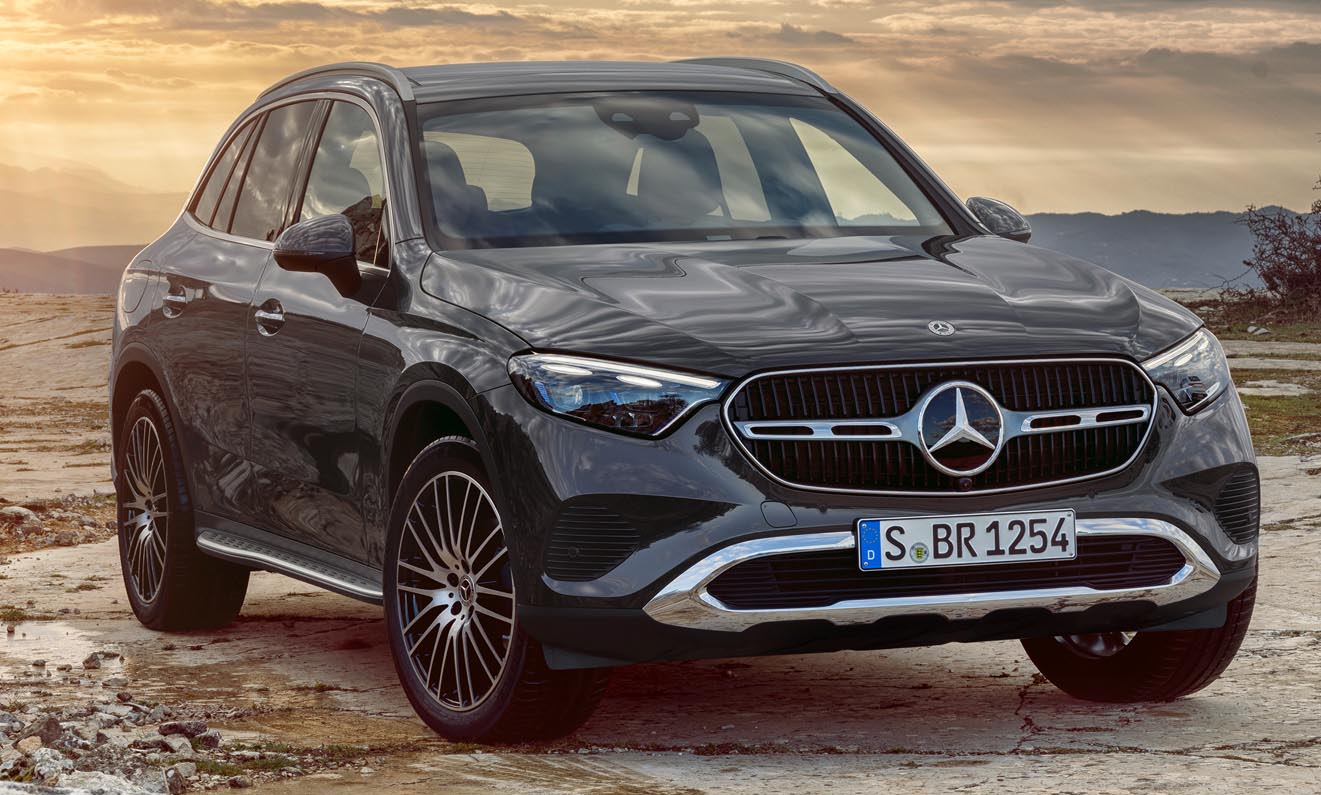
Comfort appointments: Improvements in many details
The massage function in the optional multi-contour seat has been extended and covers the entire back area: Eight inflatable air chambers in the backrest provide an improved deep-massage effect. A vibration massage is also possible on the driver’s side, and the cushion contains four corresponding motors. Up to six massage programmes are available. Three-stage seat heating for the rear seats is another new feature.
The holistic “Fit & Healthy” approach of the optional ENERGIZING package Plus makes it possible to experience the various comfort systems at the touch of a button or by voice command, and bundles them into worlds of experience in up to seven comfort programmes. At the same time, the system creates a matching atmosphere in the interior – e.g. invigorating in case of fatigue or relaxing in case of an elevated stress level. The ENERGIZING COACH suggests an appropriate fitness or wellness programme based on vehicle and trip data. It also factors the information about sleep quality and stress level into its intelligent algorithm if the driver has a suitable wearable. In conjunction with the plug-in hybrids, the “Power Nap” programme is available as a useful function, e.g. during a break at a service station or when charging the battery en route. The programme has three phases – falling asleep, sleeping, waking – and can increase performance and provide new energy.
The AIR-BALANCE package is also part of the ENERGIZING package Plus. It offers an individual, subtle fragrancing experience in the interior – according to personal preference and depending on the mood. The fragrance intensity can be regulated in three stages and different aromas are available. Thanks to refreshing ionisation and purifying filtration of the outside and inside air, the AIR-BALANCE package simultaneously contributes to improved air quality on board and to an increased sense of well-being. Active ionisation is modelled on the natural oxygen ionisation of the ambient air, e.g. resulting from the earth’s magnetic field. This can inactivate certain viruses, bacteria and spores, and therefore increase well-being. The fine particle filter based on fleece with activated carbon can reduce exposure to pollen or gaseous emissions, for instance.
The optional ENERGIZING AIR CONTROL intelligently monitors the air quality of the vehicle interior. It uses air quality and fine particle sensors for this purpose. If limit values are exceeded, it switches the air conditioning to air recirculation mode. If the values fall below the limit values, the system switches back to fresh air operation. A two-stage filter concept can additionally filter fine dust and a large proportion of pollutants from the air.
The ambience lighting available for the GLC creates an individual feel-good atmosphere in the vehicle interior by day and night. New functions improve comfort and safety compared to the preceding model. Standard equipment includes premium ambience lighting with optical fibres. The functions also include the following:
- High-quality interior light, e.g. after the vehicle is unlocked
- Dimming of the interior light when a door is opened to allow for the different brightness perceptions of passengers
- Ambience lighting extending from the dashboard to the rear doors
- 64 colours
- Ten brightness levels
- Three brightness zones
- Additional variations using programmes, colour themes and effects
- Ambience lighting in conjunction with ENERGIZING COMFORT
The optional Premium Plus ambience lighting also provides direct ambience lighting. In contrast to indirect lighting, no surfaces are illuminated here, as precise light lines emphasise the contour of the corresponding area.
The new Mercedes-Benz GLC is available with a new panoramic sunroof as an optional extra. The lined cross-strut is slimmer than in the previous version, providing an almost uninterrupted view through the larger glass roof area. If required, the panoramic sunroof can be covered with a roller blind.
Standard equipment: Significantly upgraded
Based on the luxury strategy of Mercedes-Benz, the standard equipment of the new GLC has been significantly upgraded and offers the customer a highly attractive vehicle right from the start. The AVANTGARDE Line is standard, for example, as are popular features such as the large displays, smartphone integration, wireless charging and heated front seats.
In addition, the package logic has been considerably simplified to reduce the effort of choosing from numerous individual options. Functional features that are frequently ordered together are now bundled into equipment packages on the basis of actual buyer behaviour. There are only very few functional options available beyond this. Where design options such as paint finish, upholstery, trim and wheels are concerned, customers can configure their vehicles individually as before.
GUARD 360°: Intelligent vehicle protection
The GUARD 360° vehicle protection package provides all-round monitoring. It comprises an anti-theft alarm system plus tow-away protection, which is able to detect changes in position. Movement in the vehicle interior also triggers visual and acoustic warnings. Mercedes me theft and parking collision detection informs the owner via an app. GUARD 360° vehicle protection Plus also includes vehicle locating in the event of theft as well as emergency key deactivation.
Dimensional concept and practical details: Great day-to-day operating convenience
The key dimensions of the new GLC emphasise the SUV’s even more dynamic and powerful appearance. With a length of 4,716 mm, it is 60 mm longer and 4 mm lower than its predecessor. The track widths have been increased by 6 mm at the front (now 1,627 mm) and 23 mm at the rear (now: 1,640 mm). The increased vehicle length benefits the wheelbase (plus 15 mm to 2,888 mm) and the overhangs at the front (plus 12 mm) and rear (plus 33 mm).
The vehicle width has remained the same at 1,890 mm. The new beltline exterior mirrors make a major contribution to overall vehicle aerodynamics. In its aerodynamically most favourable configuration, the minimal drag coefficient of the GLC is Cd = 0.29, two decimal points better than the predecessor (Cd = 0.31).
The luggage capacity benefits from the larger rear overhang and has increased significantly to 620 litres (+70 litres compared to the preceding model). This is noticeable in day-to-day driving, as well as during holiday journeys with the family or for everyday transport requirements. The rear seat backrest can be split-folded in a 40:20:40 ratio. Electrically operated unlocking of the rear seat backrest is done by push-button switches on the left and right side of the rear seat backrest, or via controls in the load compartment. After unlocking, the backrest sections can be folded forward. They can then be folded back into the sitting position by hand. In addition, the rear seat backrests can be adjusted to a 10-degree steeper cargo position. In conjunction with the optional Load Comfort package, the rear seat backrests can be folded electrically and the load compartment roller blind can be opened and closed electrically.
The Mercedes-Benz GLC has the EASY-PACK tailgate as standard. This opens or closes conveniently at the touch of a button: using the button on the ignition key, the switch in the driver’s door or the unlocking handle on the tailgate. More operating convenience: as in the preceding model, the roller blind and the dividing net are in two sections. The roller blind can now be stowed under the load compartment floor and the folded dividing net in a bag.
